Samsung Electronics Co SCHI925U Portable Tablet Computer with Multi-band CDMA/LTE, WLAN and Bluetooth User Manual SCH I925
Samsung Electronics Co Ltd Portable Tablet Computer with Multi-band CDMA/LTE, WLAN and Bluetooth SCH I925
Contents
User Manual 1
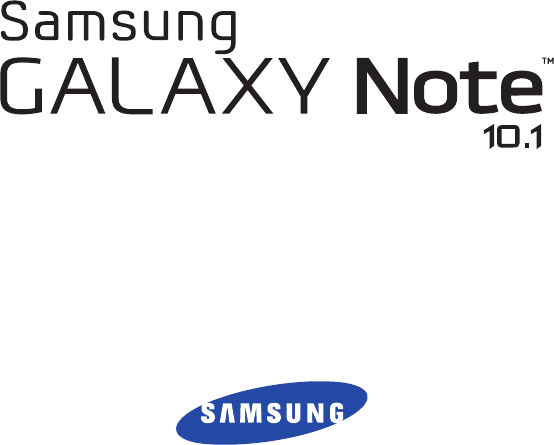
ANDROID TABLET
User Manual
Please read this manual before operating your
device and keep it for future reference.
This document is watermarked because
certain important information in the document
has not yet been verified. This document
has been sent to you as a draft and for
informational purposes only. The document
should only be used for internal purposes
and may not be distributed outside of
Samsung, except to Samsung's carrier
customer for testing purposes. Distributing
the document outside of Samsung, except
to Samsung's carrier customer for testing
purposes could result in legal exposure to
the company if the preliminary, unverified
information in the draft turns out to be
inaccurate.
DRAFT
FOR INTERNAL USE ONLY

SGH-I925_UM_Eng_LK1_CB_120612_D1
Intellectual Property
All Intellectual Property, as defined below, owned by or which is otherwise the property of Samsung or its respective suppliers
relating to the SAMSUNG Galaxy Tab, including but not limited to, accessories, parts, or software relating there to (the “Galaxy Tab
System”), is proprietary to Samsung and protected under federal laws, state laws, and international treaty provisions. Intellectual
Property includes, but is not limited to, inventions (patentable or unpatentable), patents, trade secrets, copyrights, software,
computer programs, and related documentation and other works of authorship. You may not infringe or otherwise violate the
rights secured by the Intellectual Property. Moreover, you agree that you will not (and will not attempt to) modify, prepare
derivative works of, reverse engineer, decompile, disassemble, or otherwise attempt to create source code from the software. No
title to or ownership in the Intellectual Property is transferred to you. All applicable rights of the Intellectual Property shall remain
with SAMSUNG and its suppliers.
Open Source Software
Some software components of this product, including but not limited to 'PowerTOP' and 'e2fsprogs', incorporate source code
covered under GNU General Public License (GPL), GNU Lesser General Public License (LGPL), OpenSSL License, BSD License and
other open source licenses. To obtain the source code covered under the open source licenses, please visit:
http://opensource.samsung.com
.
Disclaimer of Warranties; Exclusion of Liability
EXCEPT AS SET FORTH IN THE EXPRESS WARRANTY CONTAINED ON THE WARRANTY PAGE ENCLOSED WITH THE PRODUCT, THE
PURCHASER TAKES THE PRODUCT "AS IS", AND SAMSUNG MAKES NO EXPRESS OR IMPLIED WARRANTY OF ANY KIND
WHATSOEVER WITH RESPECT TO THE PRODUCT, INCLUDING BUT NOT LIMITED TO THE MERCHANTABILITY OF THE PRODUCT OR
ITS FITNESS FOR ANY PARTICULAR PURPOSE OR USE; THE DESIGN, CONDITION OR QUALITY OF THE PRODUCT; THE
PERFORMANCE OF THE PRODUCT; THE WORKMANSHIP OF THE PRODUCT OR THE COMPONENTS CONTAINED THEREIN; OR
COMPLIANCE OF THE PRODUCT WITH THE REQUIREMENTS OF ANY LAW, RULE, SPECIFICATION OR CONTRACT PERTAINING
DRAFT
FOR INTERNAL USE ONLY

THERETO. NOTHING CONTAINED IN THE INSTRUCTION MANUAL SHALL BE CONSTRUED TO CREATE AN EXPRESS OR IMPLIED
WARRANTY OF ANY KIND WHATSOEVER WITH RESPECT TO THE PRODUCT. IN ADDITION, SAMSUNG SHALL NOT BE LIABLE FOR
ANY DAMAGES OF ANY KIND RESULTING FROM THE PURCHASE OR USE OF THE PRODUCT OR ARISING FROM THE BREACH OF
THE EXPRESS WARRANTY, INCLUDING INCIDENTAL, SPECIAL OR CONSEQUENTIAL DAMAGES, OR LOSS OF ANTICIPATED PROFITS
OR BENEFITS.
SAMSUNG IS NOT LIABLE FOR PERFORMANCE ISSUES OR INCOMPATIBILITIES CAUSED BY YOUR EDITING OF REGISTRY SETTINGS,
OR YOUR MODIFICATION OF OPERATING SYSTEM SOFTWARE.
USING CUSTOM OPERATING SYSTEM SOFTWARE MAY CAUSE YOUR DEVICE AND APPLICATIONS TO WORK IMPROPERLY.
SAFE™: "SAFE™" (Samsung for Enterprise) is a mark for a Samsung device which has been tested against Samsung's own
internal criteria for interoperability with certain third party security-related solutions for MDM and VPN. The testing includes field
testing with local network connection and menu tree testing which tests functionality of the solutions in conjunction with the
Samsung device. During the testing, the device is tested with the security solutions to see if the solutions work with the device as
described by the third party security solution providers. The testing, for example, includes field testing with local network
connection and menu tree testing which tests functionality of the solutions in conjunction with the Samsung device. For more
information about Samsung's SAFE™ program, please refer to
www.samsung.com/us/safe
.
Disclaimer of Warranties: EXCEPT AS OTHERWISE PROVIDED IN THEIR STANDARD END USER LICENSE AND WARRANTY, TO THE
FULL EXTENT PERMITTED BY LAW SAMSUNG ELECTRONICS CO., LTD., SAMSUNG TELECOMMUNICATIONS AMERICA, LLC, AND
THEIR AFFILIATES (COLLECTIVELY REFERRED TO HEREIN AS THE "SAMSUNG ENTITIES") EXPRESSLY DISCLAIM ANY AND ALL
WARRANTIES, EXPRESS OR IMPLIED, INCLUDING ANY WARRANTY OF MERCHANTABILITY, FITNESS FOR A PARTICULAR PURPOSE,
INTEROPERABILITY OR NON-INFRINGEMENT, WITH RESPECT TO INFORMATION TECHNOLOGY SECURITY PROTECTION, SAFE™
DEVICES AND APPLICATIONS TESTED WITH SAFE™ DEVICES. IN NO EVENT SHALL THE SAMSUNG ENTITIES BE LIABLE FOR ANY
DIRECT, INDIRECT, INCIDENTAL, PUNITIVE, OR CONSEQUENTIAL DAMAGES OF ANY KIND WHATSOEVER WITH RESPECT TO
INFORMATION TECHNOLOGY SECURITY PROTECTION, SAFE™ DEVICES OR APPLICATIONS TESTED WITH SAFE™ DEVICES. In
DRAFT
FOR INTERNAL USE ONLY

addition, information technology security protection will be affected by features or functionality associated with, among other
things the e-mail platform, master data management, and virtual private network solutions selected by the software provider,
solution provider or user. Choice of an e-mail, master data management, and virtual private network solution is at the sole
discretion of the software provider, solution provider or user and any associated effect on information technology security
protection is solely the responsibility of the software provider, solution provider or user. For complete statement of limited
warranty, please refer to
www.samsung.com/us/safe
, available on the web and where Samsung smartphone and Galaxy Tab™
devices are sold. [101212]
Samsung Telecommunications America (STA), LLC
©2012 Samsung Telecommunications America, LLC. Samsung is a registered trademark of Samsung Electronics Co., Ltd.
Headquarters:
1301 E. Lookout Drive
Richardson, TX 75082
Customer Care Center:
1000 Klein Rd.
Plano, TX 75074
Toll Free Tel: 1.888.987.HELP (4357)
Internet Address:
http://www.samsung.com
DRAFT
FOR INTERNAL USE ONLY

Do you have questions about your Samsung Mobile Device?
For 24 hour information and assistance, we offer a new FAQ/ARS System (Automated Response System) at:
www.samsung.com/us/support
Nuance®, VSuite™, T9® Text Input, XT9® Smart Input, and the Nuance logo are trademarks or registered trademarks of Nuance
Communications, Inc., or its affiliates in the United States and/or other countries.
The Bluetooth® word mark, figure mark (stylized “B Design”), and combination mark (Bluetooth word mark and “B Design”) are
registered trademarks and are wholly owned by the Bluetooth SIG.
microSDTM, microSDHCTM, and the microSD logo are Trademarks of the SD Card Association.
Google, the Google logo, Android, the Android logo, Google Play, Gmail, Google Calendar, Google Latitude, Google Maps, Google
Play Books, Google Play Music, Google Talk, Picasa, and YouTube and other marks are trademarks of Google Inc.
Wi-Fi is a registered trademark of the Wireless Fidelity Alliance, Inc.
is a trademark of SRS Labs, Inc. WOW HD technology is incorporated under license from SRS Labs, Inc.
Peel and the Peel logo are marks owned by Peel Technologies, Inc. and may be registered.
, DivX®, DivX Certified® and associated logos are trademarks of Rovi Corporation or its subsidiaries and are used under
license.
DivX Certified® to play DivX® video up to HD 720p, including premium content.
ABOUT DIVX VIDEO: DivX® is a digital video format created by DivX, LLC, a subsidiary of Rovi Corporation. This is an official DivX
Certified® device that plays DivX video. Visit
www.divx.com
for more information and software tools to convert your files into DivX
videos.
ABOUT DIVX VIDEO-ON-DEMAND: This DivX Certified® device must be registered in order to play purchased DivX Video-on-
Demand (VOD) movies. To obtain your registration code, locate the DivX VOD section in your device setup menu (
Apps
>
Settings
TM
DRAFT
FOR INTERNAL USE ONLY

1
Table of Contents
Section 1: Getting Started .......................... 4
Understanding This User Manual . . . . . . . . . . . 4
Battery . . . . . . . . . . . . . . . . . . . . . . . . . . . . . . . 5
Installing the SIM Card . . . . . . . . . . . . . . . . . . . 8
Turning Your Device On and Off . . . . . . . . . . . . 9
Setting Up Your Device . . . . . . . . . . . . . . . . . . . 9
Creating a New Google Account . . . . . . . . . . . 13
Retrieving Your Google Account Password . . . 13
Using Google Maps . . . . . . . . . . . . . . . . . . . . 14
Task Manager . . . . . . . . . . . . . . . . . . . . . . . . 14
Memory Card . . . . . . . . . . . . . . . . . . . . . . . . . 15
Galaxy Tab Accessories . . . . . . . . . . . . . . . . . 17
Securing Your Device . . . . . . . . . . . . . . . . . . . 17
Troubleshooting . . . . . . . . . . . . . . . . . . . . . . . 19
Section 2: Understanding Your Device .... 20
Features . . . . . . . . . . . . . . . . . . . . . . . . . . . . 20
Front View . . . . . . . . . . . . . . . . . . . . . . . . . . . 21
Top View . . . . . . . . . . . . . . . . . . . . . . . . . . . . 22
Back and Bottom Views . . . . . . . . . . . . . . . . . 22
S Pen . . . . . . . . . . . . . . . . . . . . . . . . . . . . . . . 23
Home Screen . . . . . . . . . . . . . . . . . . . . . . . . . 28
Navigating Your Device . . . . . . . . . . . . . . . . . 32
Notifications . . . . . . . . . . . . . . . . . . . . . . . . . . 35
Status Details . . . . . . . . . . . . . . . . . . . . . . . . . 36
Quick Settings . . . . . . . . . . . . . . . . . . . . . . . . 36
Status Bar . . . . . . . . . . . . . . . . . . . . . . . . . . . 39
App Shortcuts . . . . . . . . . . . . . . . . . . . . . . . . 40
Widgets . . . . . . . . . . . . . . . . . . . . . . . . . . . . . 41
Folders . . . . . . . . . . . . . . . . . . . . . . . . . . . . . . 42
Wallpapers . . . . . . . . . . . . . . . . . . . . . . . . . . . 43
Mini App Tray . . . . . . . . . . . . . . . . . . . . . . . . . 44
S Pen App Tray . . . . . . . . . . . . . . . . . . . . . . . . 46
Section 3: Entering Text ............................47
Samsung Keyboard . . . . . . . . . . . . . . . . . . . . 47
Text Input Methods . . . . . . . . . . . . . . . . . . . . 47
Changing the Input Method . . . . . . . . . . . . . . 47
Using the Samsung Keyboard . . . . . . . . . . . . . 48
Using the Handwriting Feature . . . . . . . . . . . . 53
DRAFT
FOR INTERNAL USE ONLY
2
Using Speech Recognition . . . . . . . . . . . . . . . . 55
Section 4: Contacts and Accounts ...........56
Accounts . . . . . . . . . . . . . . . . . . . . . . . . . . . . . 56
Contacts . . . . . . . . . . . . . . . . . . . . . . . . . . . . . 57
Groups . . . . . . . . . . . . . . . . . . . . . . . . . . . . . . 63
Favorites . . . . . . . . . . . . . . . . . . . . . . . . . . . . . 65
Section 5: Messaging ................................68
Types of Messages . . . . . . . . . . . . . . . . . . . . . 68
Email . . . . . . . . . . . . . . . . . . . . . . . . . . . . . . . . 68
Gmail . . . . . . . . . . . . . . . . . . . . . . . . . . . . . . . 76
Google Talk . . . . . . . . . . . . . . . . . . . . . . . . . . . 80
Google+ . . . . . . . . . . . . . . . . . . . . . . . . . . . . . 84
Messenger . . . . . . . . . . . . . . . . . . . . . . . . . . . 84
Section 6: Multimedia ...............................86
Media Hub . . . . . . . . . . . . . . . . . . . . . . . . . . . . 86
Game Hub . . . . . . . . . . . . . . . . . . . . . . . . . . . . 88
Music Player . . . . . . . . . . . . . . . . . . . . . . . . . . 89
Video Player . . . . . . . . . . . . . . . . . . . . . . . . . . 95
Play Movies & TV . . . . . . . . . . . . . . . . . . . . . . . 97
Gallery . . . . . . . . . . . . . . . . . . . . . . . . . . . . . . . 98
Camera . . . . . . . . . . . . . . . . . . . . . . . . . . . . . 102
Camcorder . . . . . . . . . . . . . . . . . . . . . . . . . . 106
Photo Editor . . . . . . . . . . . . . . . . . . . . . . . . . .109
Games . . . . . . . . . . . . . . . . . . . . . . . . . . . . . .111
Section 7: Connections ...........................112
Internet . . . . . . . . . . . . . . . . . . . . . . . . . . . . .112
Wi-Fi . . . . . . . . . . . . . . . . . . . . . . . . . . . . . . .120
Bluetooth . . . . . . . . . . . . . . . . . . . . . . . . . . . .122
Portable Wi-Fi Hotspot . . . . . . . . . . . . . . . . . .126
Tethering . . . . . . . . . . . . . . . . . . . . . . . . . . . .127
VPN . . . . . . . . . . . . . . . . . . . . . . . . . . . . . . . .128
Nearby devices . . . . . . . . . . . . . . . . . . . . . . .128
AllShare Cast . . . . . . . . . . . . . . . . . . . . . . . . .129
Kies Via Wi-Fi . . . . . . . . . . . . . . . . . . . . . . . .129
Managing Downloads . . . . . . . . . . . . . . . . . .130
Synchronizing with Windows Media Player . .132
Connecting as a Mass Storage Device . . . . . .132
Memory Card . . . . . . . . . . . . . . . . . . . . . . . . .133
Section 8: Applications and Widgets ..... 134
Apps Screen . . . . . . . . . . . . . . . . . . . . . . . . .134
Widgets . . . . . . . . . . . . . . . . . . . . . . . . . . . . .164
Section 9: Settings ..................................168
Accessing Settings . . . . . . . . . . . . . . . . . . . .168
Wireless and network . . . . . . . . . . . . . . . . . .169
DRAFT
FOR INTERNAL USE ONLY
3
Device . . . . . . . . . . . . . . . . . . . . . . . . . . . . . 179
Personal . . . . . . . . . . . . . . . . . . . . . . . . . . . 187
Accounts . . . . . . . . . . . . . . . . . . . . . . . . . . . 198
System . . . . . . . . . . . . . . . . . . . . . . . . . . . . 199
About device . . . . . . . . . . . . . . . . . . . . . . . . 205
Section 10: Health and Safety Information .
207
Exposure to Radio Frequency (RF) Signals . . 207
Specific Absorption Rate (SAR) Certification
Information . . . . . . . . . . . . . . . . . . . . . . . . 212
FCC Part 15 Information to User . . . . . . . . . . 214
Smart Practices While Driving . . . . . . . . . . . 214
Battery Use and Safety . . . . . . . . . . . . . . . . . 215
Samsung Mobile Products and Recycling . . . 217
UL Certified Travel Charger . . . . . . . . . . . . . 217
Display / Touch-Screen . . . . . . . . . . . . . . . . 218
GPS . . . . . . . . . . . . . . . . . . . . . . . . . . . . . . . 218
Care and Maintenance . . . . . . . . . . . . . . . . . 219
Responsible Listening . . . . . . . . . . . . . . . . . 220
Operating Environment . . . . . . . . . . . . . . . . 222
Restricting Children's Access to Your Mobile Device
224
FCC Notice and Cautions . . . . . . . . . . . . . . . 224
Other Important Safety Information . . . . . . . . 224
Section 11: Warranty Information ..........226
Standard Limited Warranty . . . . . . . . . . . . . . 226
End User License Agreement for Software . . 231
Index .........................................................239
DRAFT
FOR INTERNAL USE ONLY

4
Section 1: Getting Started
This section helps you to quickly start using your device.
Understanding This User Manual
The sections of this manual generally follow the features of
your device. A robust index for features begins on page 239.
Also included is important safety information, beginning on
page 207, that you should know before using your device.
This manual gives navigation instructions according to the
default display settings. If you select other settings,
navigation steps may be different.
Unless otherwise specified, all instructions in this manual
assume that you are starting from a Home screen. To get to a
Home screen, you may need to unlock the device. For more
information, refer to “Securing Your Device” on page 17.
Note:
Instructions in this manual are based on default settings
and may vary from your device depending on the
software version on your device and any changes to the
device’s settings.
Note:
Unless stated otherwise, instructions in this user manual
start with the device unlocked, at the Home screen.
All screen images in this manual are simulated. Actual
displays may vary depending on the software version of
your device and any changes to the device’s settings.
Special Text
In this manual, some text is set apart from the rest. This
special text is intended to point out important information,
share quick methods for activating features, define terms,
and more. The definitions for these methods are as follows:
•
Notes
: Presents alternative options for the current feature, menu,
or sub-menu.
•
Tips
: Provides quick or innovative methods or useful shortcuts.
•
Important
: Points out important information about the current
feature that could affect performance.
•
Warning
: Brings important information to your attention that can
help to prevent loss of data or functionality or damage to your
device.
DRAFT
FOR INTERNAL USE ONLY
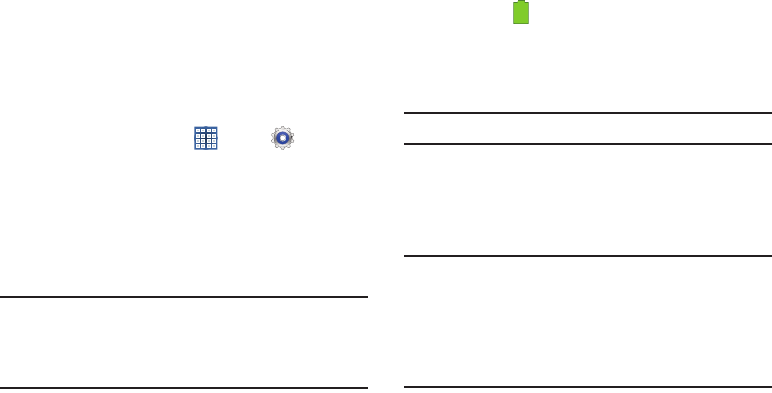
Getting Started 5
Text Conventions
This manual provides condensed information about how to
use your device. To make this possible, the following text
conventions are used to represent often-used steps:
Battery
Your device is powered by a rechargeable, standard Li-Ion
battery. A Wall/USB Charger (Charging Head and USB cable)
are included with the device for charging the battery.
Warning!
Use only approved charging devices. Approved
accessories are designed to maximize battery life.
Using other accessories may invalidate your
warranty and may cause damage.
Battery Indicator
The Battery icon in the Status Bar shows the battery
power level. When battery power is 15% or less, your device
prompts you to charge the battery. If you continue to operate
the device without charging, the device powers off. For
battery use information, see “Battery” on page 186.
Tip:
Touch the Time field to display battery charge status.
Charging the Battery
Your device comes with a Wall/USB Charger (Outlet
Connector, Charging Head, and USB cable) to charge your
device from any standard AC power outlet.
Note:
The battery comes partially charged. You must fully
charge the battery before using your device for the first
time.
After the first charge, you can use the device while
charging.
➔
Arrows are used to represent the sequence of selecting
successive options in longer, or repetitive, procedures.
For example:
From a Home screen, touch
Apps
➔
Settings
➔
Display
➔
Screen timeout
.
DRAFT
FOR INTERNAL USE ONLY
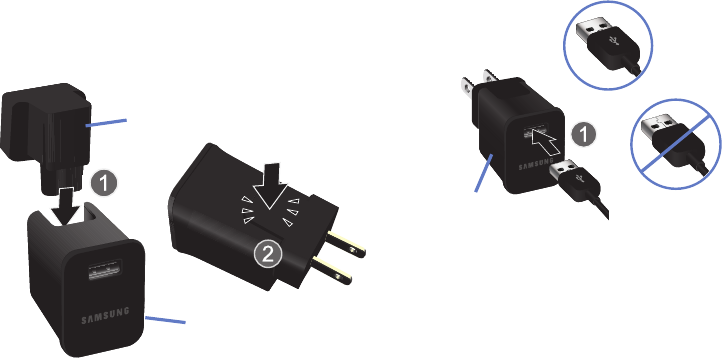
6
1. Assemble the Wall/USB Charger by removing the
protective plastic sheets from the Outlet Connector and
the Charging Head and inserting the Outlet Connector
(1) into the receptacle on the Charging Head (2) as
shown.
2. Insert the USB cable into the Charging Head (1).
Charging
Head
Outlet
Connector
Incorrect
Correct
Charging
Head
DRAFT
FOR INTERNAL USE ONLY
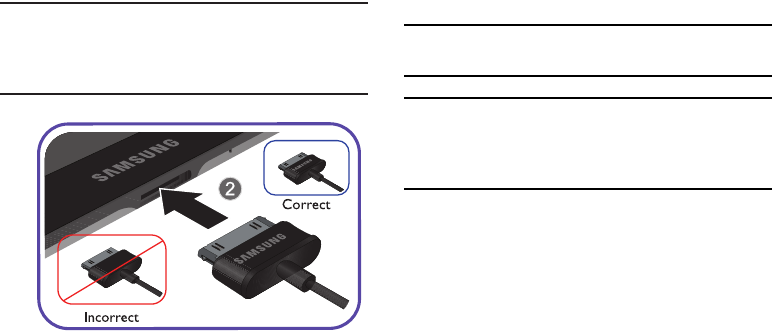
Getting Started 7
3. Insert the USB cable into the device’s Charger/
Accessory Port (2).
Warning!
While the device is charging, if the touch screen
does not function due to an unstable power supply,
unplug the USB power adapter from the power outlet
or unplug the USB cable from the device.
4. Plug the Charging Head into a standard AC power
outlet.
5. When charging is complete, unplug the Charging Head
from the power outlet and remove the USB cable from
the device.
Note:
You cannot charge the battery using the USB cable and
your PC.
Note:
If the battery is completely discharged, you cannot turn
on the device, even with the USB power adapter
connected. Allow a depleted battery to charge for a few
minutes before you try to turn on the device.
DRAFT
FOR INTERNAL USE ONLY
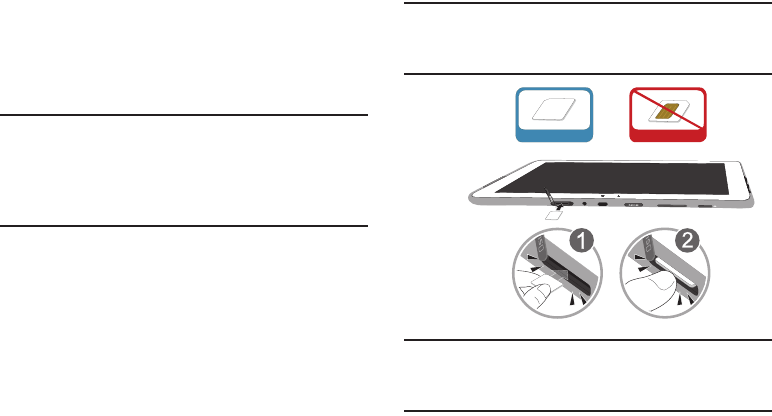
8
Installing the SIM Card
When you subscribe to a cellular network, you are provided
with a plug-in SIM card loaded with your subscription details,
such as your PIN, available optional services, and many
others features.
Important!
The plug-in SIM card information and its contacts
can be easily damaged by scratching or bending,
so be careful when handling, inserting, or
removing the card. Keep all SIM cards out of reach
of small children.
䡲
Carefully slide the SIM card into the SIM card socket (1)
until the card locks into place (2). The illustration
shows the screen facing up.
Caution!
Make sure that the SIM card’s gold contacts face
downward and that the notched corner of the card
goes in first.
Note:
If the card is not inserted correctly, the device will not
detect the SIM card. Re-orient the card back into the slot
if the SIM is not detected.
Incorrect
Correct
DRAFT
FOR INTERNAL USE ONLY
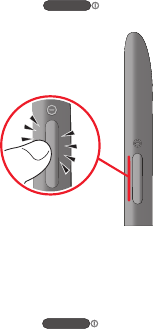
Getting Started 9
Turning Your Device On and Off
Turning Your Device On
䡲
Press and hold the
Power/Lock
Key
.
For more information, refer to
“Unlocking the Device” on
page 17.
Note
: Your device’s internal
antenna is located along the
top back of the device. Do not
block the antenna; doing so
may affect signal quality and
may cause the device to
operate at a higher power level
than is necessary. For more
information, refer to “GPS
Applications” on page 136.
Turning Your Device Off
1. Press and hold the
Power/Lock
Key
.
2. At the
Device options
prompt, touch
Power off
.
3. At the
Power off
prompt, touch
OK
.
Setting Up Your Device
When you first turn on your device, you are asked to set up a
few things. To do that, the following screens appear. Some
screens can be skipped (touch
Skip
) or re-displayed (touch
Back
). Some screens appear depending on the options you
choose.
Welcome
1. Touch the
Select language
field, scroll through the list,
and touch the language you want your device to use,
such as,
English
.
2. Touch
Start
.
No SIM Card in Device
The
No SIM card in device
screen appears if you have not
installed the SIM card that was provided with your tablet.
Ensure that you have an activated SIM card installed in your
device prior to device set-up. For more information, refer to
“Installing the SIM Card” on page 8.
䡲
Touch
Skip
to operate your tablet without the SIM card.
DRAFT
FOR INTERNAL USE ONLY

10
Wi-Fi
Make sure the Wi-Fi
OFF / ON
icon is set to ON and
choose one of the following options:
䡲
Touch
Add Wi-Fi network
to enter a Network SSID that is
not listed.
䡲
Touch
Scan
to make sure you have an accurate list of
Wi-Fi networks.
䡲
Touch one of the Wi-Fi networks in the list, enter the
password, and touch
Connect
. Touch and connect to
another Wi-Fi network or touch
Next
to continue.
䡲
Touch
Skip
to perform this task later. (For more
information, refer to “Wi-Fi” on page 169.)
Set Date and Time
1. Touch the time zone field (
GMT
)
and select the correct
time zone.
2. Under
Date
, set the date (month, day, year), if
necessary.
3. Under
Time
, set the time (hour, minute, and AM or PM),
if necessary.
4. Touch
Next
.
Samsung Account
Sign in to your Samsung account to use Samsung services.
1. Touch
variety of services
to learn more.
2. Touch
Create new account
to create a Samsung
account.
– or –
Touch
Sign in
if you already have a Samsung account.
– or –
Touch
Skip
to perform this task later.
DRAFT
FOR INTERNAL USE ONLY

Getting Started 11
Got Google?
To use all of the Android features of your tablet, you need to
create a Google™ Account the first time you use your
device. With a Google Account, Google applications,
including Gmail, Maps, Navigation, Google Talk, and Google
PlayTM, will always be in sync between your tablet and
computer.
The
Got Google?
screen lets you create and sign in to a new
Google account or simply sign in to an existing Google
account.
Note:
If you skipped Wi-Fi setup, the Wi-Fi setup screen
displays and you must connect through a Wi-Fi network.
1. Respond to the “
Do you have a Google Account?
” as
follows:
•
If you already have a Google account, touch
Yes
. The
Sign in
screen appears.
•
Touch the
Email
field.
–
Enter your Google account Email ID and touch
Next
on the
keyboard.
–
Enter your Google account password and touch
Done
on the
keyboard.
•
If you do not have a Google account, touch
No
. The
Make it
Google
screen appears.
–
To create and sign in to a new Google account, touch
Get an
account
.
–
To bypass this step and proceed, touch
Not now
.
•
Once you enter your Google account information, you are
prompted to agree to the Google Terms of Service and Privacy
Polich. Touch
OK
.
The
Signing in
screen appears until your tablet is linked to your
Google account.
For more information, refer to
“Setting Up
Your Gmail Account”
on page 76.
DRAFT
FOR INTERNAL USE ONLY
12
Enable Purchases
This screen displays if you signed in to your Google account.
䡲
Enter purchase information for your Google Play
account and touch
Save
.
– or –
Touch
Skip
.
Backup and Restore
This screen also displays if you signed in to your Google
account.
1. Read the backup and restore information.
2. Enable either or both options.
3. Touch
Next
.
The Restoring screen displays while your information is
being restored.
Use Google Location
1. Read the information on the screen and enable either
or both of the Google location services.
2. Touch
Next
to continue.
This Tablet Belongs To ...
To personalize the tablet with your name:
1. Touch the First and Last fields and use the on-screen
keyboard to enter you first and last name.
2. Touch
Next
.
Free Dropbox Account
Dropbox is a cloud file storage subscription service. Using a
Dropbox account, you can save files and access them with
multiple devices from multiple locations.
To get a free 50 GB Dropbox account for two years:
1. Touch
Disclaimer
to read a short disclaimer about this
offer.
2. Touch
OK
.
3. Touch
Create a new Dropbox account
, enter the required
fields, and touch
Register for Dropbox
.
– or –
Touch
I already have an account
to sign in to Dropbox.
– or –
Touch
No thanks
to skip this offer.
DRAFT
FOR INTERNAL USE ONLY

Getting Started 13
Google Services
This screen displays if you did not sign in to your Google
account. The use of this device is subject to the privacy
policy and other terms.
1. Touch
Learn more
to read the privacy policy and other
terms.
2. Touch
Next
, if you agree that your device may receive
and install updates from Google.
Setup Complete
Congratulations! Your device is set up and ready to use.
䡲
Touch
Finish
.
The main Home screen displays.
Creating a New Google Account
Your new device uses a Google account to fully use its
Android features, including Gmail, Maps, Navigation, Google
Talk, and Google PlayTM.
If you did not create a new account during the setup
procedure when you first turned your tablet on, follow these
steps:
1. From a Home screen, touch
Apps
➔
Gmail
.
The
Add a Google Account
screen displays.
2. Touch
New
to create a new Google account.
For more information, refer to “Setting Up Your Gmail
Account” on page 76.
Retrieving Your Google Account
Password
A Google account password is required for Google
applications. If you misplace or forget your Google Account
password, follow these instructions to retrieve it:
1. From your computer, use an Internet browser to
navigate to
http://google.com/accounts
.
2. Once the web page loads, click on
Can’t access your
account?
and follow the on-screen instructions.
DRAFT
FOR INTERNAL USE ONLY
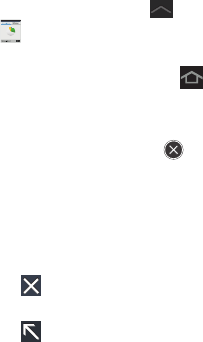
14
Using Google Maps
In order to use some applications related to Google Maps,
you must first connect Wi-Fi. (For more information, refer to
“Wi-Fi” on page 169.)
You must also enable location services to use Google Maps.
Some features require Standalone or Google location
services. (For more information, refer to “Location services”
on page 187.)
Task Manager
Your device can run applications simultaneously and some
applications run in the background.
Use Task Manager to see which applications are running on
your device and to end running applications to extend battery
life. You can also uninstall applications from your device and
see how much memory is used by applications.
Task Manager Pop-Up
The Task manager pop-up provides information about
Active
applications
and includes a
RAM manager
. It also has a link to
the Task Manager application.
To access the Task manager pop-up:
1. From a Home screen, touch
Mini App Tray
➔
Task manager
.
– or –
From any screen, touch and hold
Home
.
The Task manager pop-up displays.
2. Touch the
Active applications
tab to view applications
running on your device. Touch to end an
application or
End all
to stop all running applications.
3. Touch the
RAM manager
tab to display the amount of
Random Access Memory (RAM) currently in use. Touch
Clear memory
to clear inactive and background
processes.
4. Touch in the top right corner of the Task manager
pop-up to close the application.
5. Touch in the top left corner to display the Task
Manager application.
DRAFT
FOR INTERNAL USE ONLY

Getting Started 15
Task Manager Application
The Task Manager application provides information about
applications, including
Active applications
,
Downloaded
,
RAM
manager
,
Storage
, and
Help
.
To access the Task Manager:
1. Access Task Manager from the Task manager pop-up.
For more information, refer to “Task Manager Pop-Up”
on page 14.
– or –
Add the Application monitor widget to a Home screen
and then touch
Application monitor
on the Application
monitor widget. For more information, refer to
“Widgets” on page 41.
– or –
Touch
Navigation
and then touch
Task manager
.
2. Touch
Active applications
to view applications running
on your device. Touch
End
to end an application or
End all
to end all running applications.
3. Touch
Downloaded
to view applications installed from
Google Play. Touch
Uninstall
to remove an application
from your device.
4. Touch
RAM manager
to display the amount of Random
Access Memory (RAM) currently in use. Touch
Clear
memory
to clear inactive and background processes.
5. Touch
Storage
to view internal (Device memory) and
external (SD card) storage memory statistics.
6. Touch
Help
to view useful tips for extending battery life.
Memory Card
Your device supports removable microSD™ or microSDHC™
memory cards with maximum capacities of 32 GB
(depending on the memory card manufacturer and type).
Memory cards are used to store music, photos, videos, and
other files.
Note:
You can only store music files that you own (from a CD
or purchased with the device) on a memory card.
DRAFT
FOR INTERNAL USE ONLY
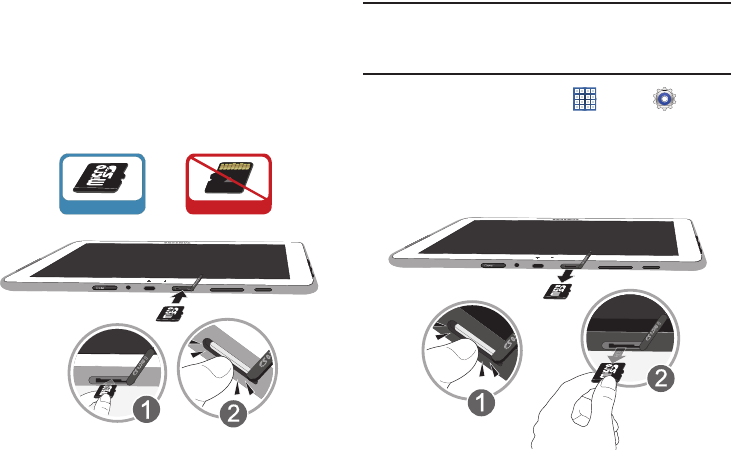
16
Installing a Memory Card
1. Open the Memory Card Slot cover and turn to expose
the slot.
2. With the gold contacts facing down, carefully slide the
memory card into the slot (1), pushing gently until it
clicks into place (2).
3. Replace the Memory Card Slot cover.
Removing a Memory Card
Important!
To prevent damage to information stored on the
memory card, unmount the card before removing it
from the device.
1. From a Home screen, touch
Apps
➔
Settings
➔
Storage
.
2. Under
SD card
, touch
Unmount SD card
.
3. Open the Memory Card Slot cover and turn to expose
the slot.
Correct Incorrect
DRAFT
FOR INTERNAL USE ONLY

Getting Started 17
4. Gently press down on the memory card (1), so that
it pops out from the slot, and carefully pull the card
out (2).
5. Replace the Memory Card Slot cover.
For more information, refer to “Memory Card” on page 133.
Galaxy Tab Accessories
To find accessories for your Galaxy Tab:
1. Go to
http://www.samsung.com/us/mobile/galaxy-tab-
accessories
.
Galaxy Tab accessories display.
2. Use your model number to find compatible
accessories.
Securing Your Device
By default, the device locks automatically when the screen
times out or you can lock it manually. You can unlock the
device using one of the default Unlock screens or, for
increased security, use a personal screen unlock pattern.
For more information about creating and enabling a Screen
unlock pattern, see “Lock screen” on page 188.
For other settings related to securing your device, see
“Location services” on page 187.
Note:
Unless stated otherwise, instructions in this User Manual
start with the device unlocked, at the Home screen.
Locking the device manually
䡲
Press the
Power/Lock Key
.
Unlocking the Device
1. Press the
Power/Lock Key
.
DRAFT
FOR INTERNAL USE ONLY
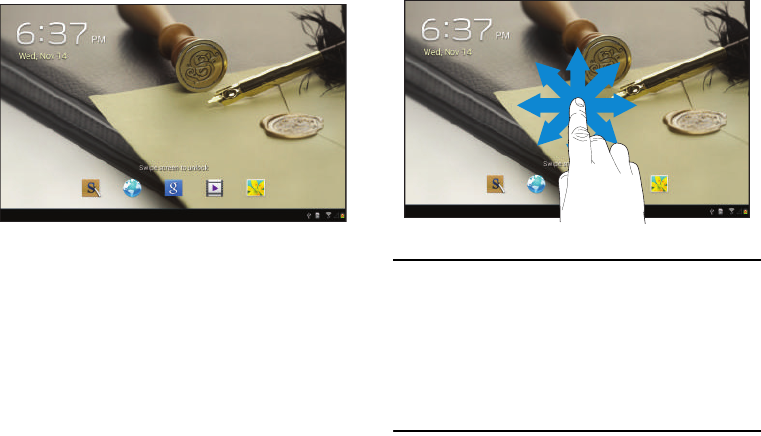
18
The Lock screen displays. 2. Swipe across the screen as shown.
The last accessed screen displays.
Tip:
You can launch any of five applications from the Lock
screen. Just touch and swipe one of the app shortcut
icons to launch its associated application.
You can change your Lock screen settings to enable
access to the Popup Note application by using your S Pen.
(For more information, refer to “Lock screen” on
page 188.)
DRAFT
FOR INTERNAL USE ONLY
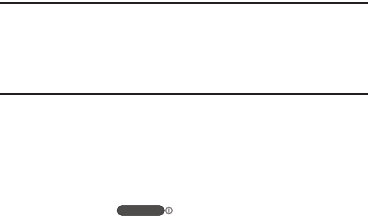
Getting Started 19
Note:
You can customize the Lock screen and set the type of
Screen Unlock you want to use (Face unlock, Pattern,
PIN, or Password). For more information, see “Lock
screen” on page 188 and see “Security” on page 191.
Troubleshooting
If your device has fatal errors, hangs up, or freezes, you may
need to reset the device to regain functionality.
•
If your device is frozen and unresponsive, press and hold the
Power/Lock Key
for 8 to 10 seconds.
DRAFT
FOR INTERNAL USE ONLY

20
Section 2: Understanding Your Device
This section outlines key features of your device and
describes the screen and the icons that appear when the
device is in use. It also shows how to navigate through the
device.
Features
•
10.1-inch WXGA (1280x800) TFT (PLS) LCD touch screen
•
Android
TM
Version 4.0.4, Ice Cream Sandwich
•
SAFE™ Certified
•
CDMA 1X/EV-DO Rev-A /LTE Wireless Technology
•
Bluetooth
®
4.0
Wireless technology. For more information, refer
to
“Bluetooth”
on page 170.
•
Built-in Wi-Fi technology (802.11 b/g/n)
•
3.2 Megapixel camera and camcorder plus 0.3 Megapixel
forward-facing VGA camera
•
Full integration of Google applications (Gmail, YouTube
TM
,
Google Maps
TM
, and Voice Search)
•
Messaging Features:
–
Gmail
TM
–
Email (corporate and personal)
–
Google Talk
TM
(Instant Messaging and Video Chat)
•
Photo Gallery that supports GIF, AGIF, JPEG, PNG, BMP, WBMP,
and WEBP formats
•
HD Video Player (720p)
–
Codec: MPEG4, H.264, H.263, VC-1, DivX, VP8, WMV7/8,
Sorenson Spark
–
Format: 3GP (MP4), WMV (ASF), AVI (DivX), MKV, FLV, WEBM
•
DivX Certified
®
to play DivX
®
video up
to HD 1080p
, including
premium content
•
Supports HDMI/MHL connections to connect electronic devices to
high-definition televisions (HDTVs) and displays.
•
Music player that supports MP3, AAC/AAC+/EAAC+, WMA,
OGG (vorbis), FLAC, AC-3 (only with video), and Vorbis formats
•
1GB RAM memory and 16GB on-board memory, which is used for
data storage and access
•
Support for microSD
TM
and microSDHC
TM
Memory Cards
DRAFT
FOR INTERNAL USE ONLY
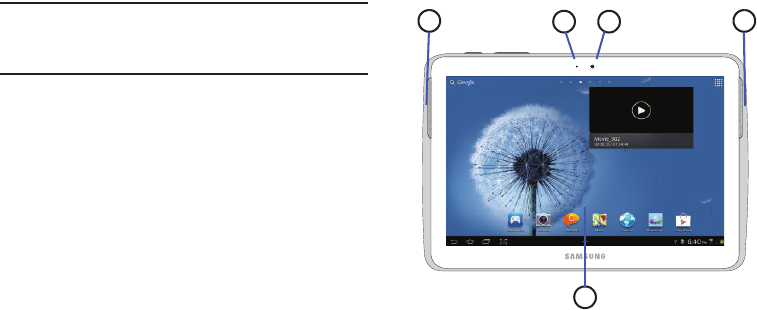
Understanding Your Device 21
•
Preloaded applications such as AllShare Play
TM
, Google Play
TM
Books,
Google Play
TM
Store, Polaris
®
Office, and Samsung
Media Hub. (For more information, refer to
“Applications and
Widgets”
on page 134.)
Warning!
This device does not support some USB storage
media devices. (For more information, refer to
“Galaxy Tab Accessories” on page 17.)
Front View
The following items can be found on the front of your device
as illustrated.
1.
External Speakers
: Used in music or video playback,
notification tones, and for other sounds.
2.
Light Sensor
: Used to control screen brightness
automatically and when taking photos with the
front-facing Camera.
3.
Front-facing Camera Lens
: Used when taking photos or
recording videos.
4.
Display Screen
: The orientation of the display screen
rotates with the tablet as you turn it. You can turn this
function on or off. (For more information, refer to
“Quick Settings” on page 36.)
4
1 1
32
DRAFT
FOR INTERNAL USE ONLY
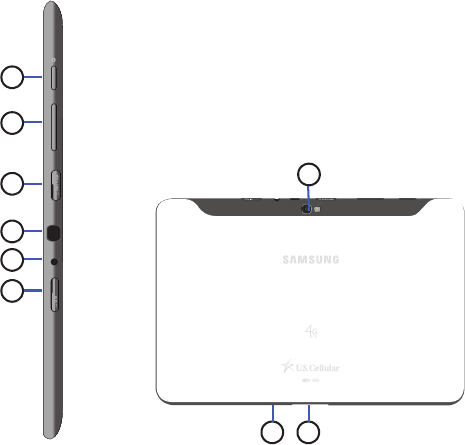
22
Top View
The following items can be found on the top
of your device as illustrated.
1.
Power/Lock Key
: Press and hold to
turn the device on or off. Press to
lock the device or to wake the screen
for unlocking.
2.
Volume Key
: From a Home screen,
press to adjust Master Volume.
During music playback, press
to
adjust volume.
3.
Memory Card Slot
: Install a memory
card for storage of files.
4.
Infrared Blaster
: Used to emit infrared
signals used for controlling external
devices. For more information, refer
to “Smart Remote” on page 161.
5.
3.5mm Headset Jack
: Plug in for
headphones.
6.
SIM Card Port
: Insert your SIM card
here.
Back and Bottom Views
The following items can be found on the back and bottom of
your device.
1.
Camera Lens
: Used when taking photos or recording
videos.
2.
Microphone
: Used for video chat.
3.
Charger/Accessory Port
: Plug in a USB cable for
charging or to sync music and files.
1
2
3
6
4
5
1
2 3
DRAFT
FOR INTERNAL USE ONLY
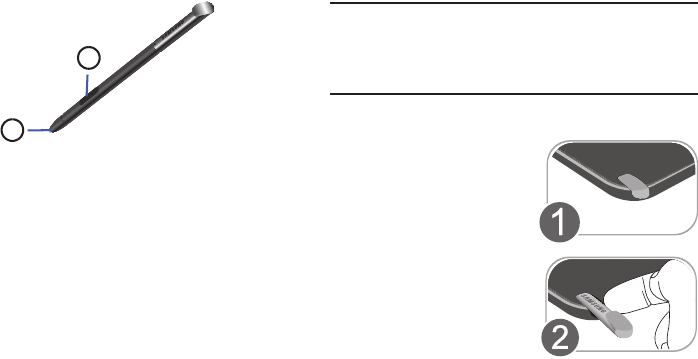
Understanding Your Device 23
S Pen
With the S Pen stylus, you can do anything you can do with
one finger, only more accurately.
You can also use the S Pen with compatible applications,
such as S Note or Photoshop Touch, to do things you cannot
do with your finger.
1.
Stylus tip
: Used for touching and dragging accross the
screen.
2.
Pen button
: Used to access additional functions for the
S Pen. (For more information, refer to “Using the S
Pen” on page 25.)
Removing the S Pen From Your Tablet
The S Pen is conveniently stored in your tablet to protect it
and to keep it available.
Tip:
Removing the S Pen awakens your tablet’s screen (if
dark), unlocks the screen if the lock is set to Swipe, and
launches the S Pen App Tray. (For more information, refer
to “S Pen App Tray” on page 46.)
To remove the S Pen, follow these steps:
1. Locate the S Pen at the
lower right corner of the
device (1).
2. Use your fingernail or a
sharp object to pull the
end of the S Pen out of
the device (2).
2
1
DRAFT
FOR INTERNAL USE ONLY
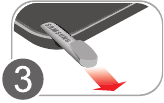
24
3. Pull the S Pen out of the
device (3).
Rich S Pen Functionality
•
Air View
: Hover S Pen over the screen to preview information.
•
Effectively express yourself
: Write/Draw directly into an email,
or the calendar, annotate Word, Excel, PowerPoint, and PDF
documents, capture your ideas in S Note, write a note on the back
of the picture.
•
Quick Command
: Launch Quick Command to activate frequently
used applications or actions. Press the S Pen button and then
drag the S Pen up the screen to display the Quick Command
window.
•
Easy Clip
: Instantly outline and crop anything on the screen and
freely edit or share with others.
DRAFT
FOR INTERNAL USE ONLY

Understanding Your Device 25
Using the S Pen
There are several different functions you can perform using
the S Pen.
S Pen Screen Operations
The S Pen can be used for various screen operations.
•
Touch a command button, such as
Back
, or icons, such as
Apps
or
Email
, with the S Pen instead of your finger.
The result is the same at touching the button or icon with your
finger.
•
To sweep a list or menu, touch and drag the screen up or down.
•
To sweep to the next Home screen panel, touch and drag the
screen to the left or right.
Back Function
To move to a previous screen, hold the S Pen button and
touch and drag the screen as shown in the illustration below.
The previous screen displays.
Press S Pen
Button
DRAFT
FOR INTERNAL USE ONLY
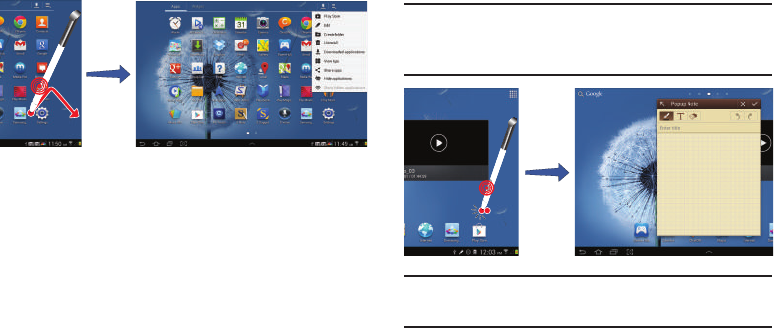
26
Menu Button
To display the menu from any screen, hold the S Pen button
and touch and drag the screen as shown in the illustration
below. The menu displays.
Launch Popup Note
Popup Note is an application that you can launch from any
screen to take quick notes or jot down ideas. To open Popup
Note, hold the S Pen button and double-tap the screen.
Tip:
You can also change the Lock screen’s settings to let you
launch Popup Note from the Lock screen. (For more
information, refer to “Lock screen” on page 188.)
Tip:
To take more complex notes, access the full S Note
application. (See “S Note” on page 158.)
Press
S Pen
button
Press
S Pen
button
DRAFT
FOR INTERNAL USE ONLY
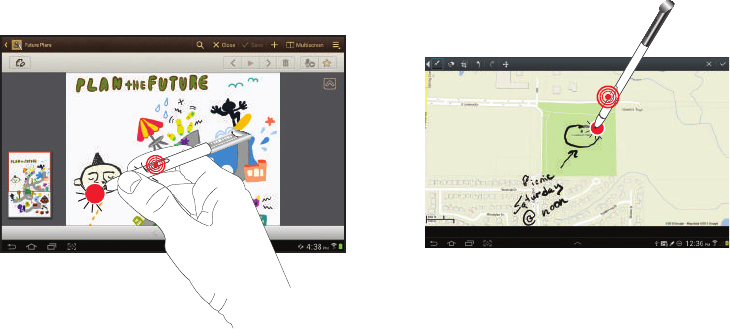
Understanding Your Device 27
Screen Capture
To take a screen capture, press and hold the S Pen button
and touch and hold the S Pen anywhere on the screen. Files
are saved in the
My Files
➔
All files
➔
sdcard0
➔
Pictures
➔
Screenshots
folder. You can also find them in your Gallery
in the
Screenshots
album.
Write on any Screen after Capture
To write on a screen capture, use the pen to draw or write.
Files are saved in the
My Files
➔
All files
➔
sdcard0
➔
Pictures
➔
Screenshots
folder.
For information on using your S Pen with the S Note
application, see “S Note” on page 158.
Press
S Pen
button
Press
S Pen
button
DRAFT
FOR INTERNAL USE ONLY
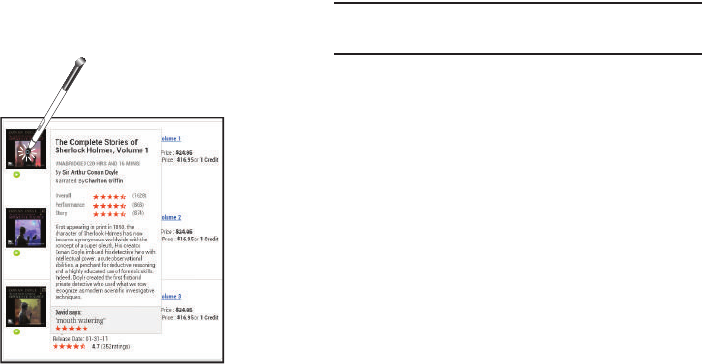
28
Air view
When you hold the S Pen near the screen, a pointer appears
on the screen. Move the pointer to files, subjects, or options
to preview the contents or view information in pop-up
windows.
You can scroll through panels or lists by moving the pointer
to an edge (top/bottom/left/right) of the screen.
Home Screen
The Home screen is the starting point for using your tablet.
Note:
Unless stated otherwise, instructions in this user manual
start with the device unlocked, at the Home screen.
1.
Google Search
: Search the web by typing or speaking.
For more information, refer to “Google” on page 149.
2.
Home screen
: The starting point for using your device.
Place shortcuts, widgets and other items to customize
your device to your needs.
3.
Panel Indicator
: Indicates which Home screen panel is
displayed. For more information, refer to “Extended
Home Screen” on page 30.
4.
Widget
: Applications that run on the Home screen
panels. (For more information, refer to “Widgets” on
page 41.)
5.
Apps
: Display the Apps screen.
6.
Back
: Return to the previous screen or option.
7.
Home
: Display the central Home screen. Touch and
hold to display the Task Manager pop-up.
DRAFT
FOR INTERNAL USE ONLY
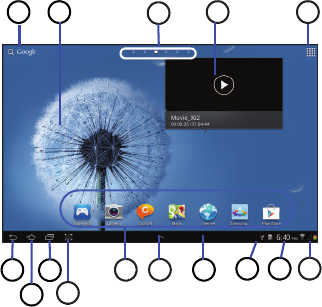
Understanding Your Device 29
8.
Recent Apps
: Open a list of thumbnail images of apps
you have worked with recently. Touch an App to open
it. Touch
Task manager
to display the Task Manager.
9.
Quick Launch
: This soft key can be set to launch
several different applications. The default setting is
Screen capture
. (For more information, refer to “Quick
launch” on page 183.)
10.
App Shortcuts
: Shortcuts to applications. (For more
information, refer to “App Shortcuts” on page 40.)
11.
Mini App Tray
: Shortcuts to apps that you can use
anytime, such as a Alarm, Calculator, and Calendar.
(For more information, refer to “Mini App Tray” on
page 44.)
12.
System Bar
: The area along the bottom of the Home
screen where you can find navigation buttons and
icons that show notifications, battery power, and
connection details.
13.
Notification Icons
: Presents icons to show notifications
from the system or from an application. Touch a
Notification Icon to display more detail. (For a list of
icons, see “Status Bar” on page 39.)
14.
Time
: The current time. (For more information, refer to
“Date and time” on page 201.)
15.
Status Icons
: Indicate the status of your tablet. Touch
the Time / Status Icons area to display the Status
Details panel. (For more information, refer to “Status
Bar” on page 39.)
7
6
12
12
814
13
9
54
15
3
1110
DRAFT
FOR INTERNAL USE ONLY

30
Display Settings
You can customize display screen settings to your
preferences. (For more information, refer to “Display” on
page 182.)
Extended Home Screen
The Home screen consists of the Home panel and four
additional panels that extend beyond the display width to
provide more space for adding shortcuts and widgets.
Slide your finger left and right across the screen to scroll to
other Home screen panels. As you scroll, the indicator at the
top of the screen shows the currently displayed Home screen
panel.
Customizing the Home Screen Panels
To customize the Home screen panels to suit your
preferences:
1. Navigate to one of the Home screen panels.
2. Touch and hold on the screen until the
Home screen
pop-up appears.
3. To change the Home screen and/or Lock screen
wallpaper, touch
Set wallpaper
. (For more information,
refer to “Wallpapers” on page 43.)
4. Under
Add to Home screen
the following options are
available:
•
Apps and widgets
: Add application shortcuts or widgets to
the current Home screen panel.
•Folder
: Add a folder to the current Home screen panel. (For
more information, refer to
“Folders”
on page 42.)
•Page
: Add a Home screen panel. (For more information, refer
to
“Adding Home Screen Panels”
on page 31.)
Note:
The center panel displays when you touch
Home
.
DRAFT
FOR INTERNAL USE ONLY
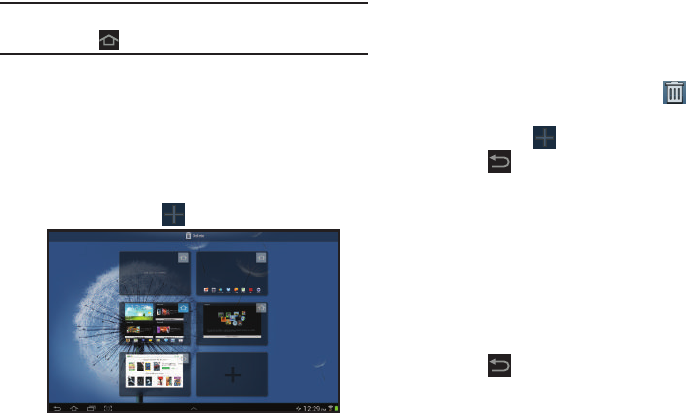
Understanding Your Device 31
Adding Home Screen Panels
Your device comes with five active Home screen panels. You
can add panels to a maximum of 7.
Note:
Home screen panel 3, the center panel, displays when
you touch
Home
.
1. Touch and hold on a Home screen panel until the
Home
screen
pop-up displays. Under
Add to Home screen
,
touch
Page
.
– or –
From a Home screen panel, pinch the screen from the
left and right side to the center to display the editing
screen. Then touch on a panel to add (enable) it.
Removing Home Screen Panels
You can remove (disable) Home screen panels you aren’t
using.
1. From a Home screen panel, pinch the screen from the
left and right side to the center to display the editing
screen.
2. To remove (disable) a Home screen panel, touch the
unwanted panel and drag it over the
Remove
icon.
The contents of the selected panel are erased and
replaced with .
3. Touch
Back
to return to the Home screen.
Rearranging Home Screen Panels
You can change the order the Home screen panels appear
when you swipe across the home screen.
1. From a Home screen panel, pinch the screen from the
left and right side to the center to display the editing
screen.
2. To rearrange the order of panels, touch and drag a
panel to a new location.
3. Touch
Back
to return to the Home screen.
DRAFT
FOR INTERNAL USE ONLY
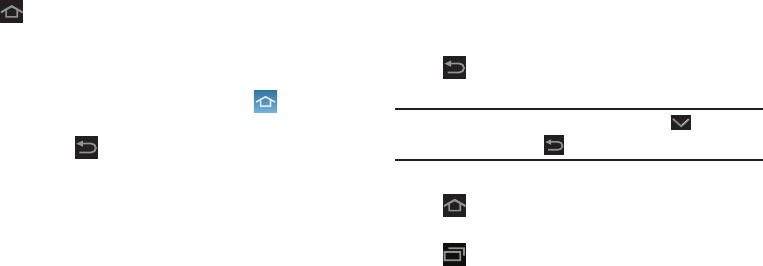
32
Selecting a New Home Screen
You can change which Home screen panel appears you touch
Home
.
1. From a Home screen panel, pinch the screen from the
left and right side to the center to display the editing
screen.
2. To select a new Home screen, touch in the upper
right corner of the desired panel.
3. Touch
Back
to return to your new Home screen.
Navigating Your Device
Use command buttons and the touch screen to navigate.
Command Buttons
Back
Touch
Back
to return to the previous screen, option, or
step.
Note:
When the on-screen keyboard is active,
Close
Keyboard
replaces
Back
.
Home
Touch
Home
to return to the Home screen.
Recent Apps
Touch
Recent Apps
to open a list of thumbnail images of
apps you have worked with recently. Touch an App to open it.
Touch
Remove all
to clear all thumbnail images.
Touch
Task manager
to display the Task Manager.
DRAFT
FOR INTERNAL USE ONLY
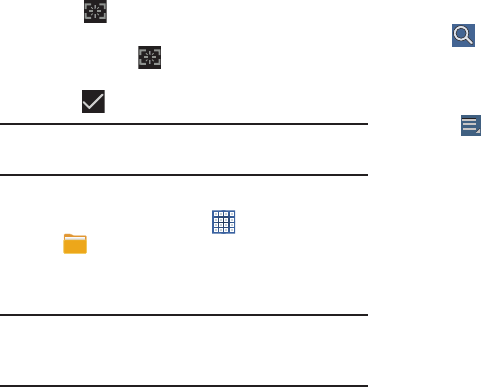
Understanding Your Device 33
Screen Capture
1. Touch
Screen Capture
to capture and add an
image of the current screen to the clipboard.
2. Touch and hold
Screen Capture
to capture an
image of the current screen and edit the image, then
touch
Save
to save the image.
Note:
A copy of the screenshot is automatically saved to the
clipboard.
To view the screen shots:
1. From a Home screen, touch
Apps
➔
My Files
.
2. Touch
sdcard
➔
Pictures
➔
Screenshots
.
3. Touch a screen capture file to display it.
Note:
This soft key can be modified to launch other
applications. (For more information, refer to “Quick
launch” on page 183.)
Other Buttons
Google Search
Touch
Google
to search the web or your device.
Context-Sensitive Menus
Context-sensitive menus offer options for features or
screens. To access context-sensitive menus:
•
Touch
Menu
to display a list of options.
•
Touch an option in the list.
Application Bar
The Application Bar is the area along the top of various
application screens. It usually contains Search and Menu
buttons, as well as other buttons that are used to display
options and settings.
Screen Navigation
Touch
Touch items to select or launch them. For example:
•
Touch the on-screen keyboard to enter characters or text.
•
Touch a menu item to select it.
•
Touch an application icon to launch the related application.
DRAFT
FOR INTERNAL USE ONLY

34
Touch and Hold
Activate on-screen items. For example:
•
Touch and hold a widget on the home screen to move it.
•
Touch and hold on a field to display a pop-up menu of options.
Swipe, Flick, or Slide
Swipe, flick, or slide your finger vertically or horizontally
across the screen. For example:
•
Unlocking the screen.
•
Scrolling the Home screens or a menu.
Pinch
Use two fingers, such as your index finger
and thumb, to make an inward pinch
motion on the screen, as if you are picking
something up, or an outward motion by
sweeping your fingers out.
For example, pinch a photo in the
Gallery
app or a web page
in the
Internet
app to zoom in or out.
Using Motions
By activating the various gesture features within the Motion
Settings menu, you can access a variety of time saving
functions.
To activate motion:
1. From the Home screen, touch the Time / Status Icons
area to display the Status Details panel. (For more
information, refer to “Status Bar” on page 39.)
2. Touch
Settings
➔
Motion
.
3. Touch the ON/OFF slider located at the top
of the screen to activate motion.
4. Touch the check box located to the right of each motion
option you wish to activate. A check mark will appear.
The following is a description of the available gestures:
•
Tilt to zoom
: Once enabled, you must be on a screen where
content can be zoomed.
–
In a single motion, touch and hold two points on the display.
–
Tilt the tilt the device back and forth to zoom in or out.
•
Pan to move icon
: Once enabled, you must be on a Home screen
panel.
–
Touch and hold a desired application shortcut icon or widget on
the screen until it detaches.
OFF
DRAFT
FOR INTERNAL USE ONLY
Understanding Your Device 35
–
Move the device left or right to migrate it to a new location.
•
Pan to browse images
: Once enabled,
–
Touch and hold a desired on-screen image to pan around it.
–
Move the device left or right to pan vertically.
–
Move the device up and down to pan horizontally around the
large on-screen image.
Notifications
When you receive a notification, the Notification icon displays
in the System Bar, to the left of the Time. Notifications
indicate the arrival of Gmail, Email, alarms, and more.
•
For more detail, touch a Notification icon.
For example, touch a Gmail Notification icon to see who sent the
message.
•
To open the Notifications list to view all of your current
notifications, touch the Time field.
–
To display a Notification in the list, touch the item.
For example, touch a Gmail entry to open the Gmail application
and view the message.
Most apps that send notifications, such as Email and Gmail,
have individual settings that can be configured. See the
settings for individual applications in the applicable section
of this user manual.
DRAFT
FOR INTERNAL USE ONLY
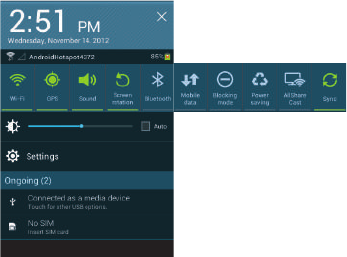
36
Status Details
To display the current date and time, battery status, and
Wi-Fi connectivity status, open Status Details.
1. Touch the Time in the Status Bar.
The Status Details display. If you have any current
notifications, their summaries are listed below the
Notifications title.
2. Touch a notification summary to respond to it.
3. Touch outside the Status Details screen to close the
window.
Quick Settings
To view and control the most common settings for your
tablet, as well as accessing the complete Settings
application, open the Quick Settings panel.
1. Touch the Time in the System Bar.
The Quick Settings pop-up displays.
DRAFT
FOR INTERNAL USE ONLY
Understanding Your Device 37
2. Touch the time at the top of the pop-up to display a
Date and time pop-up. The following options are
available:
•
Touch
Automatic date and time
or
Automatic time zone
to use network-provided date and time or time zone.
•
Touch
Use 24-hour format
to enable the 24-hour format.
•
Touch
Manual setup
to display the Date & time settings
screen. (For more information, refer to
“Date and time”
on
page 201.)
3. The Quick Settings are:
•Wi-Fi
: Touch to enable or disable Wi-Fi. For more information,
refer to
“Wi-Fi”
on page 120.
•GPS
: Touch to enable or disable
Standalone GPS services
.
(For more information, refer to
“Location services”
on
page 187.)
• Sound / Mute
: Touch to enable or disable sound mode.
• Screen rotation
: When On the screen rotates automatically
from landscape to portrait and vice versa. When Off the screen
is fixed in the current mode, either portrait or landscape. (For
more information, refer to
“Quick Settings”
on page 36.)
• Bluetooth
: Touch to enable or disable Bluetooth. For more
information, refer to
“Bluetooth”
on page 122.
Sweep the pop-up to the left to see additional settings.
• Mobile data
: Disables mobile data so you can no longer use
applications such as Browser, Email, and YouTube using a
mobile network.
• Blocking mode
:
• Power saving
: When enabled, your device automatically
analyzes the screen and adjusts the brightness to conserve
battery power. (For more information, refer to
“Power saving
mode”
on page 185.)
•AllShare Cast
:
•Sync
: Synchronizes your device with the network.
Synchronizes contacts, email, time, and a variety of accounts.
These additional options are available:
•Brightness
: Touch and drag the slider to set the brightness or
touch
Auto
to allow the device to set brightness automatically
based on available light and battery charge status. (For more
information, refer to
“Brightness”
on page 182.)
•Settings
: Touch to open the Settings application. For more
information, refer to
“Settings”
on page 168.
DRAFT
FOR INTERNAL USE ONLY
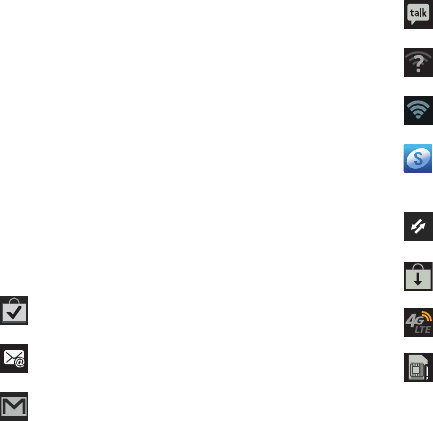
38
• Notifications
: Displays system notifications. For more
information, refer to
“Notifications”
on page 35.
4. Touch
Clear
to remove Notification Icons from the
System Bar.
5. Touch a notification entry to display the details.
6. Close the Quick Settings by touching
X
in the upper,
right corner of the Quick Settings pop-up or by
touching outside the Quick Settings screen.
Notifications
Quick Settings also displays icons under the
Notifications
heading to alert you to activity on the tablet such as new
messages, application downloads, software updates, and
more. The following table lists those icons.
Download Successful
: A recent application download
or update completed successfully.
New Email Message
: You have new email. Touch
Reply to view and answer the email.
New Gmail Message
: You have new Gmail. Touch the
icon for additional information.
Google Talk Invitation
: Someone has invited you to
chat using Google Talk.
Wi-Fi networks available
: An open Wi-Fi network is
in range.
Wi-Fi Connected
: Your device is connected to a Wi-Fi
network.
Samsung account
: Set up your Samsung account.
(For more information, refer to “Samsung Account”
on page 10.)
Software update
: There is a software update
available for this device.
Updates Available
: Updates to the applications you
have downloaded are available.
SIM Installed
: A SIM card is installed in your tablet.
No SIM
: A SIM card has not been installed in your
tablet.
DRAFT
FOR INTERNAL USE ONLY
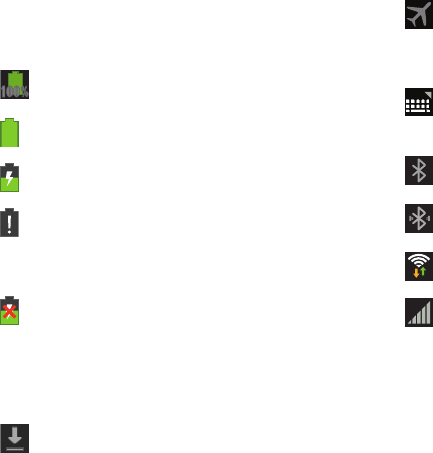
Understanding Your Device 39
Status Bar
The Status Bar is part of the System Bar and displays icons
to show network status, battery power, and other details.
Battery Fully Charged
: When the battery is fully
charged, this indicator is displayed.
Battery Level
: Shown fully charged.
Charging Indicator
: Battery is charging.
Device Power Critical
: Battery has only three percent
power remaining. At about 15 percent power
remaining, a popup is displayed to remind you to
charge immediately.
USB Connection Indicator
: The device is connected
to a computer using a USB cable, but it is not
charging. The battery is only charged while
connected to a computer, if the device is turned off.
When the device is off, press the Power/Lock key to
see the battery charging indicator.
Download in progress
: An application is being
downloaded to the device.
Airplane Mode
: Indicates that the Airplane Mode is
active, which allows you to use many of your
device’s features, but it cannot access online
information or applications.
Set up input methods
: When the keyboard is being
displayed, touch this icon to display a menu of quick
keyboard settings.
Bluetooth Active
: Bluetooth is turned on. For more
information, refer to “Bluetooth” on page 122.
Bluetooth Connected
: Your device is connected to a
Bluetooth device.
Wi-Fi Active
: Wi-Fi is connected, active, and
communicating with a Wireless Access Point (WAP).
Signal Strength
: Displays your current signal
strength. The greater the number of bars, the
stronger the signal.
DRAFT
FOR INTERNAL USE ONLY
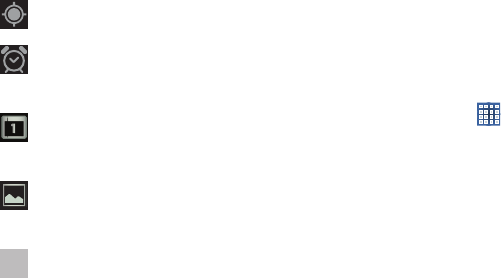
40
App Shortcuts
Use App Shortcuts for quick access to applications or
features, such as Email or Camera.
1. Navigate to the Home screen on which you want to
place the App Shortcut.
2. Touch
Apps
.
– or –
Touch and hold on the screen until the
Home screen
options pop-up displays.
Under
Add to Home screen
touch
Apps and widgets
.
3. Touch the
Apps
tab.
4. Touch and hold the application icon, then slide your
finger where you want to place the icon and release it.
(For a list of applications, see “Apps Screen” on
page 134.)
5. Touch and hold the App Shortcut and then drag the
application icon to reposition it on the Home screen.
GPS Active
: Displays when GPS is active.
Alarm Set
: Displays when you set an alarm to ring at
a specified time. (For more information, refer to
“Alarm” on page 137.)
Event
: This is a notification for one or more events.
(For more information, refer to “Creating an Event or
Task” on page 142.)
Screenshot Captured
: A screenshot has been
captured. (For more information, refer to “Screen
Capture” on page 33.)
Nearby Devices
: The Nearby devices setting is
enabled. (For more information, refer to “Nearby
devices” on page 178.)
DRAFT
FOR INTERNAL USE ONLY
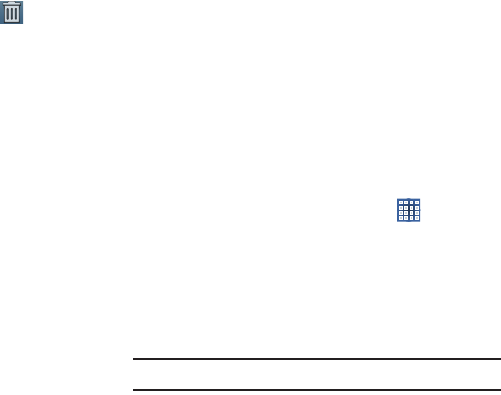
Understanding Your Device 41
Removing App Shortcuts
䡲
Touch and hold the App Shortcut until
Delete
displays at the top of the screen, then drag the App
Shortcut to the
Delete
icon.
Widgets
When you first turn on your tablet, there are various widgets
on the center Home screen. They can also appear on the
Home screens to the left and right of the center Home
screen.
Widgets are self-contained applications that you can place
on the Home screens to access your favorite features.
Adding Widgets to a Home screen
1. Navigate to the Home screen panel on which you want
to place the Widget.
2. From that Home screen panel, touch
Apps
.
– or –
Touch and hold on the Home screen panel until the
Home screen
options pop-up displays.
Under
Add to Home screen
touch
Apps and widgets
.
3. Touch the
Widgets
tab.
Note:
Swipe across the screen horizontally to view all Widgets.
4. Touch and hold the Widget’s icon, then slide your finger
where you want to place the icon and release it.
DRAFT
FOR INTERNAL USE ONLY
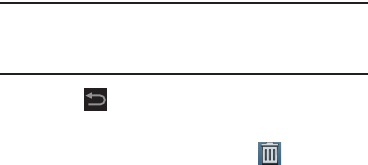
42
Note:
There must be room on the screen where you want to
place the widget, otherwise the widget will not add to
the Home screen.
5. Touch
Back
to return to the Home screen.
Removing Widgets
䡲
Touch and hold the Widget until the
Remove
icon
displays at the top of the screen, then drag the Widget
and drop it over the
Remove
icon.
Folders
Place Folders on the Home screen to organize items together
on the Home screen.
Adding Folders
To create a folder on a Home page:
1. Navigate to the desired Home screen.
2. Touch and hold on the screen until the
Home screen
pop-up displays.
3. Under
Add to Home screen
touch
Folder
.
A new folder displays on the Home screen.
DRAFT
FOR INTERNAL USE ONLY

Understanding Your Device 43
Managing Folders
To name a folder:
䡲
Touch the folder, touch the
Unnamed folder
field, and
use the keyboard to enter a name for the folder.
To add an App shortcut to a folder:
1. Add the App shortcut to the Home screen that the
folder is on.
2. Touch and hold the App shortcut, drag it to the folder,
and drop it.
To remove an App shortcut from a folder:
1. Touch the folder to view the contents.
2. Touch the App shortcut, drag it out of the folder, and
drop it on the Home screen.
Removing a Folder
䡲
Touch and hold the folder until the
Delete
icon
displays, then drag the folder toward the top of the
screen and drop it over the
Delete
icon.
Note:
Any App shortcuts in the folder are deleted.
Wallpapers
You can choose a picture to display on the Home Screen,
Lock screen, or on both the Home and Lock screens. Choose
from preloaded wallpaper images or select a photo you have
downloaded or taken with the Camera.
1. From a Home screen, touch and hold on the screen.
The
Home screen
options pop-up displays.
2. Touch
Set wallpaper for
.
The Set wallpaper for pop-up displays.
3. Touch
Home screen
,
Lock screen
, or
Home and lock
screens
.
DRAFT
FOR INTERNAL USE ONLY

44
The
Select wallpaper from
pop-up displays the
following options:
• Gallery
: Access the Gallery to select a photo. Touch a photo to
select it. Crop and resize the picture, if desired. Touch
Done
to
save the picture as wallpaper. Touch
Cancel
to cancel.
•Live wallpapers
: Choose from pre-loaded interactive animated
wallpapers. Touch a wallpaper to see an example. If available,
touch
Settings
to view options for the selection. Touch
Set
wallpaper
to save your choice. Touch
Back
to return to
the Live wallpapers menu.
• Wallpapers
: Choose from pre-loaded wallpaper images. Touch
an image to view it. Touch
Set wallpaper
to save it as
wallpaper. Touch
Back
to return to the Home screen.
Note:
Live wallpapers is not available for the Lock screen.
Mini App Tray
There are shortcuts available that link to apps that you might
need while working in other apps, such as Alarm, Calculator,
Calendar, Email, Music Player, Task manager, and World
Clock. In some cases, these shortcuts are actually links to
the part of the app you need most and they contain a link to
the actual app where you can use other functions.
1. From any screen, touch
Mini App Tray
at the
bottom, center of the screen.
The Mini App Tray icons display.
2. Touch one of the icons to display a mini app pop-up.
The pop-up varies depending on the application.
Various controls display at the top of the pop-up and
other information is displayed in the body of the
pop-up.
DRAFT
FOR INTERNAL USE ONLY

Understanding Your Device 45
3. Touch options (such as ) to create new app items
(such as alarms or events).
4. Touch items in the body of the pop-up, such as an
email entry or keys on the Calculator.
5. Touch to link to the application. (For more
information, refer to “Changing the Apps Screen” on
page 134.)
6. Touch to close the mini app pop-up.
7. Touch
Edit
at the right side of the tray to customize the
Mini App Tray. (For more information, refer to
“Customizing the Mini App Tray” on page 45.)
Customizing the Mini App Tray
You can choose applications to display on the Mini App Tray
and arrange them in any order.
1. From any screen, touch
Mini App Tray
at the
bottom, center of the screen. The Mini App Tray pops
up at the bottom of the screen.
2. Touch
Edit
at the right side of the tray.
3. To remove an app from the Mini App Tray, touch the
app icon. The icon disappears from the Mini App Tray
and “jumps” to the Mini App Tray applications list.
4. To change the location of an app icon in the Mini App
Tray, touch and drag the icon to another position in the
tray.
5. Touch
Done
to save your changes.
DRAFT
FOR INTERNAL USE ONLY
46
S Pen App Tray
The S Pen App Tray gives you quick access to the S Pen-
enabled applications on your tablet.
1. Remove the S Pen from its storage slot at the bottom
right side of your tablet.
The S Pen App Tray pops-up on the side of the display,
with the following applications available:
•Popup Note
: Handwrite, draw, save, and share quick memos.
•S Note
: Create notes with productivity tools that turn
handwriting into typed text and correct drawn shapes, lines,
and formulas to make them perfect. (For more information,
refer to
“S Note”
on page 158.)
•Calendar
: Record events and appointments to manage your
schedule. A shortcut to Calendar displays on a Home screen by
default. (For more information, refer to
“Calendar”
on
page 141.)
• Crayon physics
: Your drawings are transformed into physical
objects in a game in which you solve puzzles with your artistic
vision and creative use of physics.
•PS
(Photoshop)
Touch
: Combine images, apply effects, and
share your results with friends and family through social
networking sites.
• Polaris Office
: Manage your Office documents online or offline.
(For more information, refer to
“Polaris Office”
on
page 157.)
• S Pen Settings
: Tailor your tablet’s responses to your use of the
S Pen, such as, when you remove the S Pen from its slot,
whether to play sounds and what action to take or app to
launch. (For more information, refer to
“S Pen”
on
page 200.)
2. To launch an app in the S Pen App Tray, touch the app’s
icon with your S Pen.
DRAFT
FOR INTERNAL USE ONLY
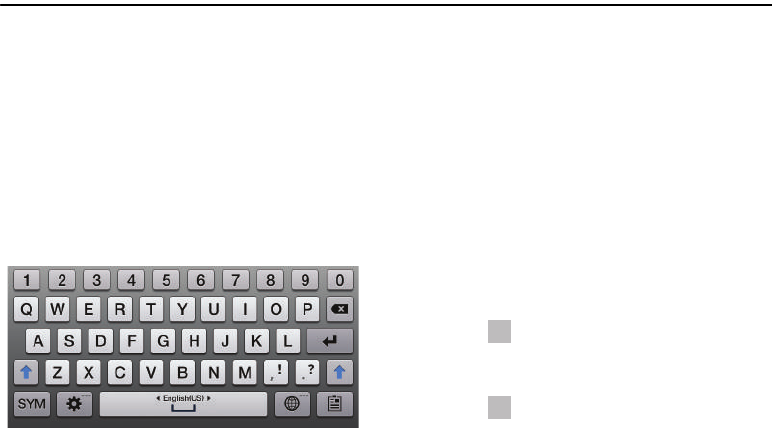
Entering Text 47
Section 3: Entering Text
This section describes how to enter words, letters,
punctuation and numbers when you need to enter text.
Samsung Keyboard
Your device uses a virtual QWERTY keyboard for text entry
called the Samsung keyboard. Use the keyboard to enter
letters, punctuation, numbers, and other characters into text
entry fields or applications. Access the keyboard by touching
any text entry field.
The keyboard displays at the bottom of the screen. By
default, when you rotate the device, the screen orientation
updates to display the keyboard at the bottom of the screen.
Text Input Methods
Your device offers two text input methods.
•
Google voice typing
: You can use your voice to enter text
using the Voice input feature. Your device recognizes your
speech and enters text for you. For more information, refer
to “Using Speech Recognition” on page 55.
•
Samsung keyboard
: The Samsung keyboard is also a virtual
QWERTY keyboard that allows you to enter text by touching keys
on the screen. The Samsung keyboard includes predictive text,
which matches your key touches to common words so that you
can select the word to enter it into your text.
Changing the Input Method
When entering text, you can select the text input method.
1. Touch
Set up input methods
in the Status bar.
The Set up input methods pop-up displays.
2. Touch an input method to activate it.
3. Touch to display that input method’s settings.
(For more information, refer to “Keyboards and input
methods” on page 193.)
DRAFT
FOR INTERNAL USE ONLY

48
Using the Samsung Keyboard
The Samsung keyboard is a custom virtual QWERTY
keyboard, featuring predictive text. Input characters by
touching the on-screen keys with your finger or use speech
recognition.
As you enter characters, predictive text matches your key
touches to common words and displays them. Select a word
from the display to insert it into your text. For more
information, refer to “Using XT9 Predictive Text” on page 49.
Your tablet also provides handwriting recognition to make the
task of text entry that much easier.
Configuring the Keyboard
To configure the Samsung keyboard to your preferences:
䡲
Touch
Set up input methods
in the Status bar and
then touch next to
Samsung keyboard
in the Set
up input methods pop-up.
– or –
Touch and hold
Options
on the keyboard and slide
to
Settings
.
The Samsung keyboard settings screen displays.
(For more information, refer to “Keyboards and input
methods” on page 193.)
Entering Upper and Lower Case Letters
The default case is lower case (abc). Enter upper and lower
case alphabet letters by touching the Shift key to toggle
the case, before touching the letter key(s).
•
Touch once to switch from abc to Abc mode.
•
Touch twice to switch to ABC mode. When ABC mode is enabled,
the Shift key background turns blue.
New
Paragraph
Shift
Delete
Space Bar Select
Text
Key
Key
Input
Mode
Remove
Language
Settings/
Voice Input/
Handwriting/
Clipboard
Keyboard
DRAFT
FOR INTERNAL USE ONLY

Entering Text 49
Entering Symbols and Numbers
The number keys are displayed at the top of the keyboard
and are always available.
To enter common symbols, touch to switch to Symbols
mode, then touch the corresponding key.
There are two pages of symbols. Touch to switch to the
next page.
Touch and hold a vowel key (A, E, I, O, U, or Y) or the C, N, or
S key to open a small window where you can chose an
accented vowel or other alternate letter. Slide to the letter
until it is highlighted, and release.
Touch and hold the Period key ( . ) to open a small window
with a set of common symbols.
Other Keyboard Functions
Touch to select the language, if more than one language
has been set. The current language displays on the space
bar.
Touch and hold
Options
and slide to
Handwriting
to
use the Handwriting feature. (For more information, refer to
“Using the Handwriting Feature” on page 53.)
Touch and hold
Options
and slide to
Clipboard
to
view the clipboard and manage saved text.
Using XT9 Predictive Text
XT9 is a predictive text system that has next-letter prediction
and regional error correction, which compensates for users
pressing the wrong keys on QWERTY keyboards.
1. Touch
Set up input methods
in the Status bar.
The Set up input methods pop-up displays.
2. Touch
Set up input methods
.
The Language and input settings screen displays.
3. Touch next to Samsung keyboard to display
Samsung keyboard settings.
4. Touch the Predictive text
OFF / ON
icon to turn
Predictive text ON.
5. Touch the
Predictive text
field to modify XT9 associated
settings. (For more information, refer to “Keyboards
and input methods” on page 193.)
Note:
The XT9 option is available only when ABC mode has
been selected.
DRAFT
FOR INTERNAL USE ONLY

50
6. Begin typing a word.
A list of word options displays.
7. Touch to display more words.
To add more words, see “Adding Words To Your Word
List” on page 50.
8. Continue typing your message. XT9 mode can be used
in portrait or landscape mode.
Adding Words To Your Word List
To add more word options:
1. Touch
Set up input methods
in the Status bar.
The Set up input methods pop-up displays.
2. Touch
Set up input methods
.
The Language and input settings screen displays.
3. Touch next to Samsung keyboard to display
Samsung keyboard settings.
4. Touch
My word list
.
5. Touch
Add
.
6. Use the on-screen keyboard to enter the word.
7. Touch
Done
.
Deleting Words From Your Word List
To delete words from your word list:
1. Navigate to My word list. For more information, refer to
“Adding Words To Your Word List” on page 50.
2. Touch
Delete
.
3. Touch the existing words you want to delete or touch
Select all
, and then touch
Delete
.
4. Touch
Delete
.
DRAFT
FOR INTERNAL USE ONLY

Entering Text 51
Editing Text
You can edit the text you enter in text fields by cutting,
copying, or pasting text. These operations can be performed
within and across apps. However, some apps do not support
editing some or all of the text displayed while others may
offer their own way to select text.
Editing Existing Text
To edit text that you have entered:
1. Touch the text at the point you want to edit.
The
Cursor
displays at the point you touched.
2. Touch and drag the
Cursor
to a better position, if
necessary.
3. Enter additional text or delete text by repeatedly
touching the
Delete
key.
Copying, Deleting, or Replacing Text
To select and copy, delete, or replace text:
1. Touch and hold the text or word you want to select.
The selected text is highlighted with a tab at
each end of the selection.
2. Touch and drag either tab to select more or less text.
Tip:
Touch
Select all
in the Application bar to select all text in
the field. Touch on another area of the screen or touch
Done
to deselect the text.
3. Depending on the action you want to take for the
selected text, in the Application bar touch:
• Select all
to highlight all text in the field.
•Cut
to remove the selected text.
•Copy
to save the selected text to the clipboard.
– or –
Enter text by typing or speaking to replace the
selection with what you type.
– or –
Touch the
Delete
key to delete the selected text.
DRAFT
FOR INTERNAL USE ONLY

52
Pasting Text
To paste previously copied text:
1. Touch the text at the point you want to paste the copied
text.
The
Cursor
displays at the point you touched.
2. Touch the Cursor.
A pop-up displays.
3. Touch
Paste
in the pop-up.
To paste text directly from the clipboard:
1. Touch and hold
Options
and slide to
Clipboard
to display the text saved to the
clipboard.
2. Touch a text block to paste that text where the
Cursor
is
positioned.
Closing the Keyboard
To close the keyboard:
䡲
Touch
Close Keyboard
.
Using T9 Trace
T9 Trace allows you to enter words by gliding your finger
over the virtual QWERTY keypad, lifting your finger between
words.
To enable T9 Trace:
1. From a Home screen, touch
Apps
➔
Settings
➔
Language and input
.
2. Touch next to Samsung keyboard.
The Samsung keyboard settings screen displays.
3. Touch
T9 Trace
to enable the T9 Trace option.
When enabled, a check mark appears in the check
box.
The following example shows how to enter the word “this”.
Put your finger down on the “t” and, without lifting, glide it to
the “h”, then to the “i”, then over to the “s”.
DRAFT
FOR INTERNAL USE ONLY

Entering Text 53
Here are a few tips to get you started:
•
Auto-spacing
: When you finish a word, just lift your finger and
start the next word.
•
Double letters
: Just “scribble” on the key.
•
Auto-capitalization
: T9 Trace recognizes and capitalizes the first
word of sentences. If you want to capitalize a word that is not at
the beginning of a sentence, touch the
Shift key
and then
glide over the letters in the word.
•
Contractions
: T9 Trace recognizes most words that include an
apostrophe, just swipe the letters of the word, including the
apostrophe.
•
Punctuation
: Touch and hold a key to view a punctuation menu
and make a selection.
•
Error correction
: If you make a mistake, double-tap on the word
you want to change and then glide over the letters of the correct
word.
Using the Handwriting Feature
You can enter text simply by using your finger to handwrite
letters on your screen.
1. From a screen where you can enter text, activate the
keyboard by touching a text input field on the screen.
2. If necessary, touch
Set up input methods
in the
Status bar and then touch
Samsung keyboard
.
The Samsung keyboard displays.
3. Touch and hold
Options
and slide to
Handwriting
.
The handwriting pad displays.
4. Use your finger tip to write out each character.
Note:
To properly recognize the written characters and to
prevent scratching of the LCD, do not use script.
DRAFT
FOR INTERNAL USE ONLY

54
As you write, suggestions are offered in the word options
area in case the correct letters were not recognized.
Handwriting Tips
•
For uppercase letters, write the letter larger than the lowercase
letters.
•
Write a dash (horizontal line) to add a space.
•
Delete words by sweeping backward across them.
•
To display numbers and symbols, touch and then touch a
number or symbol key. Touch the button marked 1/3, 2/3, or 3/3
to see more symbols and emoticons. Touch to exit the
numbers and symbols keyboard.
•
To return to the Samsung keyboard,
touch and hold
Options
and slide to
Keyboard
.
Handwriting Settings
To change the Handwriting settings:
1. Touch and then touch
Set up input methods
.
The Language and input settings screen displays.
2. Touch next to Samsung keyboard to display
Samsung keyboard settings.
3. Touch
Handwriting
.
The following settings can be changed:
Handwriting
Text
Delete
Input Writing /
Space
area
Line Return
Bar
Key
Settings/
Remove
Word
Options
Numbers
Select
Language
and
Symbols
Input
Mode
Voice Input/
Keyboard/
Clipboard
Keyboard
DRAFT
FOR INTERNAL USE ONLY

Entering Text 55
• Recognition time
: Set the time it takes for your tablet to
recognize what you write. Choose from 100ms, 300ms,
500ms, 1000ms, or 2000ms.
• Pen thickness
: Change the pen thickness to 1, 3, 5, 7, or 9
pixels, as the examples demonstrate.
•Pen color
: Change the pen color to black, red, blue, green, or
brown.
• Recognition type
: Set the way your tablet recognizes what you
write.
–
Complete recognition
: The letters are not entered in the text
field until you touch
Enter
, which gives you time to choose
word options.
–
Stroke recognition
: The letters are entered in the text field as
you write.
• Gesture guide
: Displays a list of gesture that can be used with
the handwriting feature.
•Tutorial
: Displays information for entering handwritten text.
•About
: Describes the version, date, and manufacturer of the
handwriting software.
4. Press repeatedly to return to your message.
Using Speech Recognition
You can use your voice to enter text using the Voice input
feature, which lets you enter text by speaking. The Samsung
keyboard recognizes your speech and enters text for you.
1. Touch
Set up input methods
in the Status bar and
then touch
Google voice typing
in the Set up input
methods pop-up to enable
Voice Input
.
– or –
Touch
Settings
and slide to
Voice Input
.
(For more information, refer to “Speech” on
page 196.)
2. At the
Listening
prompt, speak clearly and distinctly
into the microphone.
The software converts your voice to text, which is
displayed in the message.
3. Keep speaking to add more test.
4. Touch
Done
to display the Samsung keyboard.
Note:
The Speech Recognition feature works best when you
break your message down into smaller segments.
DRAFT
FOR INTERNAL USE ONLY

56
Section 4: Contacts and Accounts
This section explains how to manage contacts and accounts.
Accounts
Your device can synchronize with a variety of accounts. With
synchronization, information on your device is updated with
any information that changes in your accounts.
•
Samsung account
: Add your Samsung account. (For more
information, refer to
“Samsung Account”
on page 10.)
•
Email
: Add an Email account to sync Contacts. (For more
information, refer to
“Email”
on page 68.)
•
Facebook
: Add your Facebook account to sync Contacts.
•
Google
: Add your Google account to sync your Contacts, Calendar,
and Gmail. (For more information, refer to
“Gmail”
on page 76.)
•
LDAP
: Add an LDAP account to find entries in an LDAP directory
server.
•
Microsoft Exchange ActiveSync
: Add your Exchange account to
sync Contacts, Calendar, and Email.
Setting Up Your Accounts
Set up and manage your synchronized accounts with the
Accounts and sync
setting.
1. From a Home screen, touch
Apps
➔
Settings
➔
Accounts and sync
.
2. Touch
Add account
, then touch the account type.
3. Follow the prompts to enter your account credentials to
complete the set-up process.
4. The device communicates with account servers to set
up your account. When complete, your account
displays in the
Manage accounts
area of the
Accounts
and sync
screen.
DRAFT
FOR INTERNAL USE ONLY
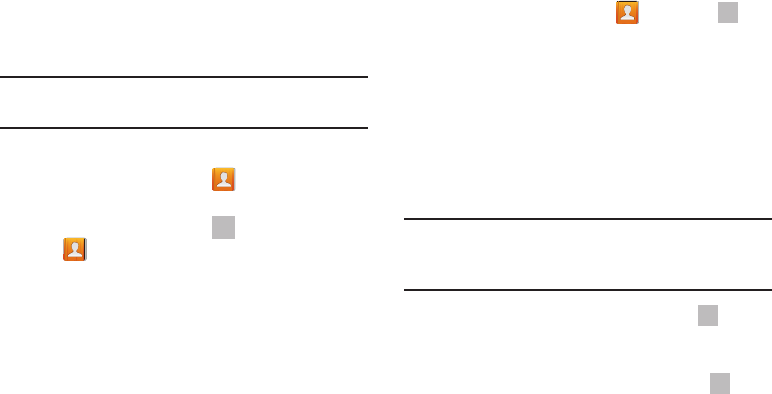
Contacts and Accounts 57
Contacts
Store contact information for your friends, family, and
colleagues to quickly access information or to send a
message.
Tip:
Contacts displays by default as a Primary shortcut on a
Home screen.
To access Contacts:
䡲
From a Home screen, touch
Contacts
.
– or –
From a Home screen, touch
Apps
➔
Contacts
.
Creating Contacts
1. From a Home screen, touch
Contacts
➔
.
2. Touch
Device
or an account.
3. Touch the
Photo ID to set up a photo to identify the
contact.
•Picture:
Choose a photo from the Gallery.
• Take picture
: Display the Camera and take a photo of the
contact.
4. Touch contact fields to display the keyboard and enter
information:
Tip:
Touch the screen and swipe up or down to display
additional fields or touch
Next
on the keyboard to move to
the next field.
•Name
: Enter a first name for the contact. Touch to enter a
Name prefix
,
First name
,
Middle name
,
Last name
, and
Name suffix
.
• Phone
: Enter a telephone number, then touch the Label
tab to choose a label from
Mobile
,
Home
,
Work
,
Work Fax
,
Home Fax
,
Pager
,
Other
,
Custom
, or
Callback
.
DRAFT
FOR INTERNAL USE ONLY

58
•Email
: Enter an email address, then touch the Label tab
to choose a label from
Home
,
Work
,
Other
, or
Custom
to
create a custom label.
•Address
: Enter an address, then touch the Label tab to
choose a label from
Home
,
Work
,
Other
, or
Custom
to create
a custom label.
• Events:
Touch
to display an event label and field. Enter
the event date, then touch the Label tab to choose a label
from
Birthday
,
Anniversary
,
Other
, or
Custom
to create a
custom event. Touch
to add additional events.
•
Groups
: Touch this field to display the Select group screen. To
assign the contact to one or more groups, touch the check box
next to each group. When enabled, a check mark
appears in the check box. For more information about Groups,
see
“Groups”
on page 63.
5.
Touch to add additional fields.
Touch to remove an
unused field.
6. Touch
Add another field
to add these additional fields:
Phonetic name
,
Organization
,
IM
,
Notes
,
Nickname,
Website
,
Internet call
, and
Relationship
.
7. Touch
Back
to remove the keyboard.
8. When you finish entering information, touch
Save
.
– or –
Touch
Cancel
➔
OK
to cancel and discard
changes.
Tip:
Display a contact’s record and touch the
Email
field to
send an email, touch the
Address
field to display the
address on a map, or touch the
Website
field to link to the
website.
DRAFT
FOR INTERNAL USE ONLY
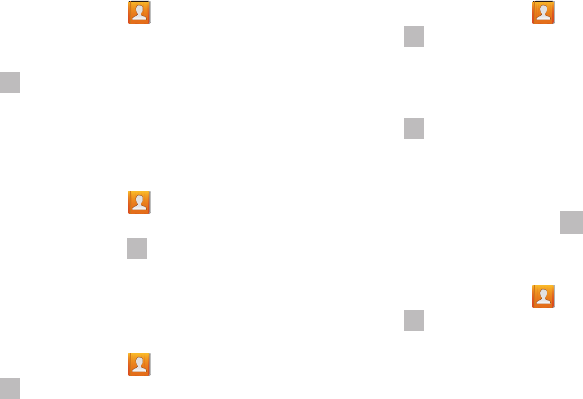
Contacts and Accounts 59
Updating Contacts
To update an existing contact:
1. From a Home screen, touch
Contacts
.
2. Touch a contact in the Contacts list to view its
information.
3. Touch
Edit
.
4. Continue entering contact information. For more
information, refer to “Creating Contacts” on page 57.
Deleting Contacts
To delete a contact:
1. From a Home screen, touch
Contacts
.
2. Touch a contact in the
Contacts
list to view its
information, and then touch
Delete
. At the prompt,
touch
OK
.
Merge Contacts with Google
You can merge a current contact with your Google account
contacts.
1. From a Home screen, touch
Contacts
.
2. Touch
Menu
➔
Merge with Google
.
3. Touch
OK
at the prompt to merge this contact with your
Google account.
Send email from Contacts
To send an email to one or more contacts:
1. From a Home screen, touch
Contacts
.
2. Touch
Menu
➔
Send email
.
3. Touch each contact you want to send an email
message or touch
Select all
. A check mark indicates
contact selection.
4. Touch
Done
.
5. Touch
Compose Email
or
Compose Gmail
.
6. Touch
Use by default for this action
if you want the
same selection each time.
7. Compose your email, then touch
Send
.
Managing Photo IDs
To remove or update a contact’s Photo ID:
1. From a Home screen, touch
Contacts
.
2. Touch
Edit
.
3. Touch the Photo ID, then touch
Remove
,
Picture
, or
Take
picture
.
DRAFT
FOR INTERNAL USE ONLY

60
Contacts Display Options
There are various ways to display your Contacts and general
Contacts settings.
1. From a Home screen, touch
Contacts
.
2. Touch
Groups
,
Favorites
, or
Contacts
, above the
Contacts List, to view contacts various ways:
•Groups
: Displays the possible Groups, such as Not assigned,
Co-workers, Family, Friends, and so on. The number of
contacts in the group is displayed next to the group name.
Touch a group name to show only contacts in that group. For
more information, refer to
“Creating a New Group”
on
page 64.
•Favorites
: Show only your favorite, or starred, contacts. For
more information, refer to
“Favorites”
on page 65.
•Contacts
: Show all your contacts. Touch the
Search
field and
enter a keyword to list contacts that contain that keyword.
3. From the
Contacts
list, touch
Menu
to display all or
some of these options:
• Delete contacts
. Touch and check mark the box next to each
contact you want to delete. Touch
Delete
and then touch
OK
.
• Merge with Google
: Merges the current contact with your
Google account contacts.
• Send email
: Sends an email to the selected contact.
•History
: Displays information about the selected contact.
•Join contact:
Join a contact to one or more other contacts.
For
more information, refer to
“Joining Contacts”
on page 62.
• Mark as default
: If a contact has multiple email addresses, for
example, touch the field that should be the default value.
• Share namecard via
: Shares the selected namecard using
Bluetooth, Email, Gmail, or through Wi-Fi Direct.
• Print namecard
: Check mark the fields you want to print and
then touch
Done
. You can only print on a Samsung printer.
• Contacts to display
: Select the contacts you want to display in
this inbox (All contacts, Google, SIM, Device, or Customized
list).
DRAFT
FOR INTERNAL USE ONLY

Contacts and Accounts 61
•Import/Export
: Use the USB cable to import your contacts
from, or export your contacts to, a storage device, such as a
PC. For more information, refer to
“Importing and
Exporting Contacts”
on page 63.
• Accounts
: Displays the Accounts and sync screen so you can
manage or synchronize this account.
•Settings
: Configure contact settings:
–
Only contacts with phones
: Touch to check the box to only
display contacts that have phone numbers.
–
List by
: List contacts by
First name
or
Last name
.
–
Display contacts by
: Display contact names as
First name
first
or
Last name
first
.
–
Contact sharing settings
: Sets parameters for sending
contact information:
4. From the
Groups
list, select a group and then touch
Menu
to display these Group-specific options:
•Search
: Search the group for a contact.
• Delete
: Touch one or more groups and touch
Delete
.
•Edit
: Change the Group name or touch
Add member
to add or
delete group members.
• Remove member
: Remove a selected member from this
group.
• Send email
: To send an email to one or more members of the
group, touch and check mark the box next to each contact you
want to send to, or touch
Select all
, and touch
Done
.
Touch
Compose Gmail
or
Compose Email
as the method for
sending the email.
• Change order
: Changes the order of how the groups display.
• Send all namecards
: Allows you to transmit all of your
current Contact entries at a single time. If the recipient
device does not support this feature, some or all Contact
entries might not be received.
• Send individual namecards
: Allows you to transmit
single contacts, one at a time. The recipient must accept
each namecard as it is received. This method of
transmission ensures all contacts are received.
DRAFT
FOR INTERNAL USE ONLY
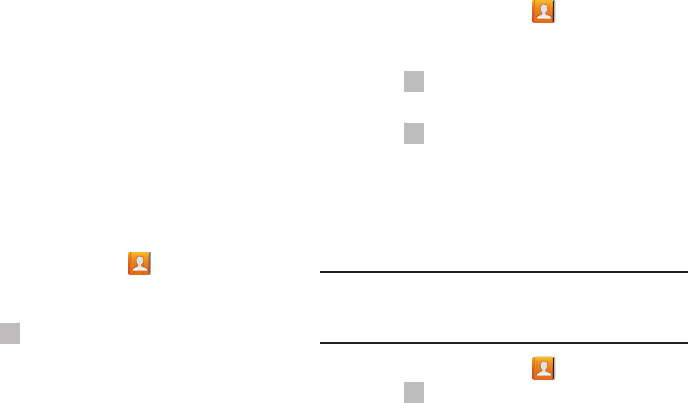
62
Linked Contacts
Your device can synchronize with multiple accounts,
including Google, Corporate Exchange, and other email
providers. When you synchronize contacts from these
accounts with your device, you may have multiple contacts
for one person.
Linking, or joining, imported contact records allows you to
see all the contact’s numbers and addresses together in one
contact entry. Linking also helps you keep your contacts
updated, because any changes that your contacts make to
their information in the respective accounts is automatically
updated the next time you synchronize with the account.
Joining Contacts
1. From a Home screen, touch
Contacts
.
2. Touch a contact in the
Contacts
list to view its
information.
3. Touch
Menu
➔
Join contact.
4. Touch the contact you want to Join.
The joined contact’s information is displayed with the
original contact’s information.
5. Repeat Step 3 and 4 to join other contacts.
Separating Contacts
1. From a Home screen, touch
Contacts
.
2. Touch a contact in the
Contacts
list to view its
information.
3. Touch
Menu
➔
Separate contact.
A list of Joined contacts displays.
4. Touch ➔
OK
to separate a joined contact.
The contact is removed from the list.
Sharing Contact Information
You can send a contact’s information by way of Bluetooth to
other Bluetooth devices or in an Email or Gmail as an
attachment.
Note:
Not all Bluetooth devices accept contacts and not all
devices support transfers of multiple contacts. Check
the target device’s documentation.
1. From a Home screen, touch
Contacts
.
2. Touch
Menu
➔
Share namecard via
.
DRAFT
FOR INTERNAL USE ONLY

Contacts and Accounts 63
Tip:
Set up a contact record for yourself to share your
information with others.
3. At the prompt, choose a sending method. Options are:
• Bluetooth
: For more information, refer to
“Bluetooth”
on
page 122.
•Email
: For more information, refer to
“Email”
on page 68.
•Gmail
: For more information, refer to
“Composing and
Sending Gmail”
on page 78.
• Wi-Fi Direct
: To send Contacts entries directly to an external
device through a Wi-Fi connection.
4. Follow the prompts to send the contact information.
Importing and Exporting Contacts
To back up and restore your contacts information, you can
export your contacts list to a storage device, such as a PC, or
import your contacts list (previously exported) from a storage
device.
1. Use the USB cable to connect your device to the
storage device.
2. From a Home screen, touch
Contacts
.
3. Touch
Menu
➔
Import/Export
.
4. Touch
Import from USB storage
,
Export to USB storage
,
Import from SD card
,
Export to SD card
,
Import from SIM
card
,
Export to SIM card
, or
Share namecard via
, then
follow the prompts to complete the operation.
Synchronize Contacts with Accounts
To synchronize your contacts with an account:
1. From a Home screen, touch
Contacts
.
2. Touch
Menu
➔
Accounts
.
3. Touch the
OFF / ON
icon to turn on
Auto-sync
.
Auto-synch controls whether changes made to
information on your device or on the web are
automatically synchronized with each other.
4. Touch to synchronize a particular account.
Groups
Assign contacts to Groups to make searching for contacts
faster or to quickly send messages to group members.
DRAFT
FOR INTERNAL USE ONLY
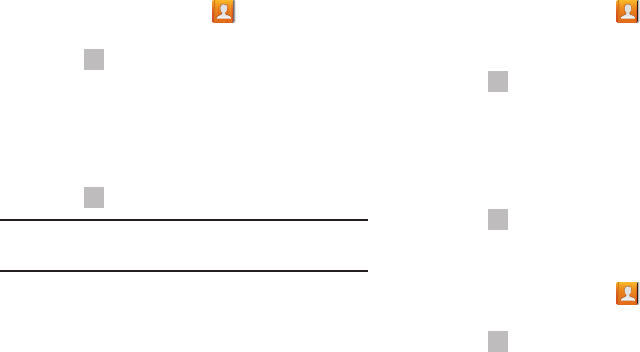
64
Creating a New Group
Create a new group when you add or edit a contact.
1. From a Home screen, touch
Contacts
.
2. Touch
Groups
above the Contacts List.
3. Touch .
4. Touch the
Group name
field and use the keyboard to
enter a new Group name.
5. Touch
Add member
to add a member to the group. For
more information, refer to “Adding Group Members”
on page 65.
6. Touch
Save
to save the new group name.
Tip:
Contacts can belong to more than one group. Just touch
the contact’s
Groups
field and touch each group.
Once you create a new group, the Contacts List can be set to
display only the contacts in that group. For more information,
refer to “Contacts Display Options” on page 60.
Renaming a Group
To rename a group that you created:
1. From a Home screen, touch
Contacts
.
2. Touch
Groups
above the Contacts List and then touch
the group you want to rename.
3. Touch
Menu
➔
Edit
.
4. Touch the
Group name
field and use the keyboard to
enter a new Group name.
5. Touch
Add member
to add a member to the group. For
more information, refer to “Adding Group Members”
on page 65.
6. Touch
Save
to save the new group name.
Deleting Groups
To delete a group that you created:
1. From a Home screen, touch
Contacts
.
2. Touch
Groups
above the Contacts List.
3. Touch
Menu
➔
Delete
.
The groups that can be deleted display.
DRAFT
FOR INTERNAL USE ONLY
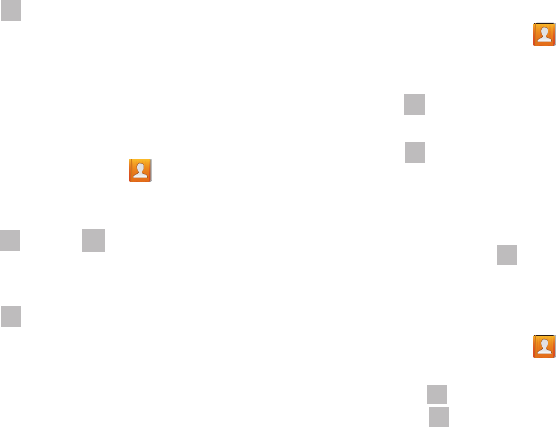
Contacts and Accounts 65
4. Touch
Select all
or the name of each group to delete.
5. Touch
Delete
to delete the groups. Choose from
Group only or Group and group members.
Adding Group Members
To add a contact to a group, just Edit a contact’s Group field.
For more information, refer to “Updating Contacts” on
page 59.
To add multiple contacts to a group:
1. From a Home screen, touch
Contacts
.
2. Touch
Groups
and then touch the group to which you
want to add members.
3. Touch
Menu
➔
Add member
.
The contacts that can be added display.
4. Touch
Select all
or the name of each contact to add.
5. Touch Done to add the contacts to the group.
Removing Group Members
To remove contacts from a group:
1. From a Home screen, touch
Contacts
.
2. Touch
Groups
and then touch the group from which you
want to remove members.
3. Touch
Menu
➔
Remove member
.
4. Touch
Select all
or the name of each contact to remove.
5. Touch Done to remove the contacts.
Contacts are removed from the group and the group
name is removed from each contact’s
Group
field.
Favorites
Mark contact records with a gold star to identify them as
favorites.
Adding Favorites
To add a contact to the Favorites
list:
1. From a Home screen, touch
Contacts
.
2. Touch a contact to display it.
3. Touch the
Star
next to the contact name so that it
turns gold .
DRAFT
FOR INTERNAL USE ONLY
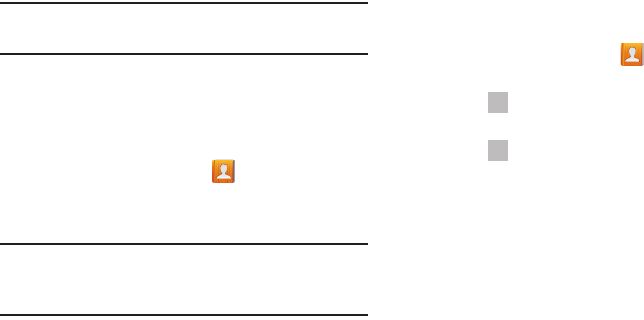
66
Tip:
You do not have to edit the contact to change the Starred
status.
Accessing Favorites
You can view your favorites two ways for fast viewing or
messaging.
To view your favorites list:
1. From a Home screen, touch
Contacts
.
2. Touch
Favorites
above the Contacts List.
Only your starred contacts display.
Note:
Touch
Groups
above the Contacts List and then touch
Starred in Android
to list the Favorites that are being
saved on your Google account.
Removing Favorites
To remove one or more contacts from your favorites list:
1. From a Home screen, touch
Contacts
.
2. Touch
Favorites
above the Contacts List.
3. Touch
Menu
➔
Remove from favorites
.
4. Touch
Select all
or the name of each contact to remove.
5. Touch Done to remove the contacts.
DRAFT
FOR INTERNAL USE ONLY

Contacts and Accounts 67
To remove one contact from your favorites list:
1. From a Home screen, touch
Contacts
.
2. Touch a contact to display it.
3. Touch the
Star
next to the contact’s name so that it
turns gray
to remove it from the Favorites list.
DRAFT
FOR INTERNAL USE ONLY

68
Section 5: Messaging
This section describes how to send and receive different
types of messages. It also includes the features and
functionality associated with messaging.
Types of Messages
Your tablet provides the following message types:
•
Email and Gmail Messages
•
Google Talk
•
Google+
•
Messenger
Email
Use Email to view and manage all your email accounts in one
application.
Configuring Email Accounts
1. From the Home screen, touch
Email
.
– or –
From a Home screen, touch
Apps
➔
Email
.
2. At the Set up email screen, enter an
Email address
and
Password
, then touch
Next
.
3. Your account’s incoming server settings are different
depending on the kind of email service for the account.
If you are asked
What type of account?
, touch the type
of account:
POP3 account
,
IMAP account
, or
Microsoft
Exchange ActiveSync
.
The Server settings screen displays. Enter the required
settings and touch
Next
. For more information, refer to
“Incoming Server Settings” on page 75.
4. Review the Account options screen. Available options
vary, depending on the provider:
• Peak schedule
: Set how often to check for new email sent to
this account during peak times. Options are: Push (Automatic),
Manual, every 15 minutes, or every 1, 4, or 12 hours.
• Off-peak schedule
: Set how often to check for new email sent
to this account during off-peak times. Options are: Push
(Automatic), Manual, every 15 minutes, or every 1, 4, or 12
hours.
DRAFT
FOR INTERNAL USE ONLY
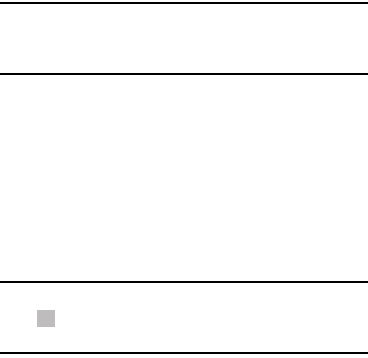
Messaging 69
• Period to sync email
: For Exchange ActiveSync accounts, set
how to store email on the tablet. Options are: Automatic, All, 1
or 3 days, 1 or 2 weeks, or 1 month.
• Emails retrieval size
: Set the maximum email retrieval size.
Options are: Headers only, 0.5, 1, 2, 5, 10, 20, 50, or100 KB,
or All.
• Period to sync Calendar
: Set how much of the calendar for
this account to sync with your tablet. Options are: 2 weeks, 1,
3, or 6 months, or All calendar.
• Send email from this account by default
: When enabled,
email from your device is automatically sent from this account.
• Notify me when email arrives
: When enabled, you receive
notifications when you receive new email sent to this account.
•Sync Email
: When enabled, email from your account is
synchronized with your device’s email.
•Sync Contacts
: When enabled, contacts from your account
are synchronized with your device’s Contacts.
•Sync Calendar
: When enabled, events from your account are
synchronized with your device’s Calendar.
• Sync Task
: When enabled, tasks from your account are
synchronized with your device’s Calendar.
• Automatically download attachments when connected to
Wi-Fi
: Enable or disable auto-download of files attached to
recent messages when connected through Wi-Fi.
5. Touch
Next
to go to the next screen or touch
Previous
to
go to the Apps screen.
Note:
For Exchange ActiveSync accounts, the Activate device
administrator? screen may appear. Read the information
and touch
Activate
to continue.
6. Enter an account name for the email account just
added, which is displayed on the email screen, and
enter Your name, if required.
7. Touch
Done
.
The device communicates with the appropriate server
to set up your account and synchronize your email.
When complete, your email appears in the Inbox for the
account.
Note:
To configure email account settings at any time, use
Menu
➔
Settings
. Touch the account to display
Account settings.
DRAFT
FOR INTERNAL USE ONLY

70
Adding Additional Email Accounts
To add additional email accounts:
1. From the Home screen, touch
Email
.
2. Touch
Menu
➔
Settings
➔
Add account
.
3. Enter the
Email address
,
Password
, and so on.
Managing Your Email Accounts
You can view email you receive for all accounts in the
Combined view
screen or you can view email accounts
individually.
1. From the Home screen, touch
Email
.
2. Touch the
drop-down menu at the top left of the
screen to select:
• Combined view
: View all email in a combined inbox.
•
<
Account Name
>: View email for the account.
Managing Your Email Conversations
In addition to managing your Email account, there are
options for changing the status of one or more Email
conversations in an account.
1. From the Home screen, touch
Email
.
2. Touch the box to the left of one or more conversations
and then choose one of the following options:
•Star
: Mark the conversations with a gold star and list
them in the Starred folder. Touch to make the changes.
– or –
Flag
: Touch
Set
to set all flags, touch
Complete
to mark all
conversations with a blue check mark, or touch
Clear
to clear all
flags and check marks. Set flags are gold.
• Mark as Read
/
Mark as Unread
: Mark the
conversations as read or unread. Once a conversation is
marked as read, it has a gray background.
•Move to :
Relocate the conversations to another folder in
the current email account or in a folder within another email
account.
•Delete
: Delete the conversations.
3. Touch
Menu
for these options:
•Sort by
: Choose a method for listing your email conversations.
•View mode
: Choose how to view your email conversations.
Choices are: Standard view and Conversations view.
• Create folder
: Create a new main folder or touch an existing
folder to create a sub-folder.
Note
: This option is not available for all email accounts.
DRAFT
FOR INTERNAL USE ONLY

Messaging 71
• Delete all
: Delete all items for this email account.
• New meeting invitation
: Use Calendar to add an event or add
a task. For more information, refer to
“Creating an Event or
Task”
on page 142.
•Settings
: Display the settings for this email account. For more
information, refer to
“Account Settings”
on page 72.
Composing and Sending Email
1. From the Home screen, touch
Email
.
2. Touch an account, if you have more than one account
set up, then touch
Compose
.
3. Enter the recipient’s email address in the
To
field.
•
If you are sending the email message to several recipients,
separate the email addresses with a comma. You can add as
many message recipients as you want.
•
Touch
to add a contact to the field.
•
Touch
+Cc/Bcc
to add additional carbon copy recipients.
–
Use the
Cc
field to carbon copy additional recipients.
–
Use the
Bcc
field to blind copy additional recipients.
•
Touch
+Me
to add yourself as a recipient.
4. Touch the
Subject
field to enter a subject.
5. Touch the body of the email to enter the text of your
email.
6. While composing a message, the following options
may be displayed:
Priority
: Set the email priority. Options are: High,
Normal, or Low.
Tracking options
: Touch
Read receipt
or
Delivery
receipt
and then touch
OK
to set the tracking
options for this email.
Security options
: Set the email security options.
Options are: Encrypt and Sign.
Attach
: Choose an attachment to add to the
message from the listed apps, such as Memo,
My Files, Picture, Audio, Video, and so on.
Undo
: Erase the previous input.
Redo
: Restore the previously erased input.
Insert
: Choose an item to insert into the message
from the listed apps, such as Picture, Memo,
Contacts, and so on.
DRAFT
FOR INTERNAL USE ONLY

72
7. Touch
Send
to send the message.
– or –
Touch
Save
to save the email to the Drafts folder.
Account Settings
Account settings lets you configure handling of email on your
device.
Note:
Available settings may depend on the email account and
include setting how much email to synchronize, creating
signatures for email you send, and other handling
options.
1. From the Home screen, touch
Email
.
2. Touch
Menu
➔
Settings
, then touch
General
Preferences
. The following options display:
• Auto-advance
: Set the screen to show after deleting a
message. Choices are: Newer message, Older message, or
Message list.
• Message preview line
: Choose a message preview line
amount. Options are: None or 1, 2, or 3 lines.
• Email title
: Set whether the Subject or Sender of the email is
shown as the time.
• Confirm deletions
: Touch the box to enable or disable this
option. A check mark indicates that deletions must be
confirmed.
Insert quick response
: Insert text that you
frequently use in email. For more information,
refer to “Account Settings” on page 72.
Font size
: Choose a text font size of 9, 10,12, 14,
16, 20, 24, 28, or 36 points.
Bold
: Bold the following text. Touch again to turn
off bold.
Italics
: This action italicizes the subsequent
entered text.
Font color
: Set the color of the text font. The bar
changes to the selected color.
Background color
: Set the color of the
background of the email.
DRAFT
FOR INTERNAL USE ONLY

Messaging 73
•Quick responses
: Edit text that you frequently use in email.
Touch an email account to display the following
settings:
Common settings
• Account name
: Enter a name to identify this account.
•Your name
: Enter a name to be used on email.
•Signature
: Touch the
OFF / ON
icon to turn
Signature on or off. Touch
Signature
and enter a signature to
add to email from this account.
• Default account
: When enabled, email from your device is
automatically sent from this account.
• Always Cc/Bcc myself
: Lets you manage whether your email
address is included in the Cc or Bcc lines.
• Forward with files
: Touch the check box to include any file
attachments when you forward an email.
• Recent messages
: Limit the number of recent messages that
are displayed on your device. Options are: 25, 50, 75, 100,
200, or Total.
•Show images
: Display images in an email.
Data usage
• Sync email
: When enabled, email from your account is
synchronized with your device’s email.
• Email check frequency
: Set how often to check for new email
sent to this account during. Options are: Never, every 15, or 30
minutes, every hour, every 4 hours, or once a day.
• Auto download attachments
: Enable or disable
auto-download of files attached to recent messages when
connected through Wi-Fi.
• Size to retrieve emails
: Set the maximum email retrieval size.
Options are: Headers only, 2, 50, or 100 KB, All, or All including
attachments.
• Auto resend times
: Set the number of auto send times.
Options are: No limit or 1, 3, 5, or 10 times.
Exchange ActiveSync settings
• Period to sync email
: Set whether to store All, 1 or 3 days, 1
or 2 weeks, or 1 month of email on the tablet.
•Empty server trash
: If available, indicates whether to delete
the contents in the server trash.
DRAFT
FOR INTERNAL USE ONLY
74
• Sync schedule
: Set up your peak and off-peak schedule
controls, which determines when your tablet checks the email
service for new email.
• Out of office settings
: Lets you set how email is handled for a
defined period of time, while you are unable to check your
email.
• Size to retrieve emails
: Set the maximum email retrieval size.
Options are: Headers only, 0.5, 1, 2, 5,10, 20, 50, or 100 KB,
or All.
• Period to sync Calendar
: When enabled, events from your
account are synchronized with your device’s Calendar.
• Security options
: Set various security options for the account.
• In case of sync conflict
: Set whether to update the server or
your tablet if there is a conflict of information between them.
• Auto resend times
: Set the number of auto send times.
Options are: No limit or 1, 3, 5, or 10 times.
Notification settings
• Email notifications
: When enabled, the New Email icon
appears in the Status Bar when a new email arrives.
• Select ringtone
: Choose a ringtone for email notifications for
this account.
Server settings
• Exchange server settings
: Configure incoming server
settings.
– or –
Incoming settings
: Configure incoming server settings. For more
information, refer to
“Incoming Server Settings”
on
page 75.
• Outgoing settings
: Configure outgoing server settings. For
more information, refer to
“Outgoing Server Settings”
on
page 75.
• Sync Email
: When enabled, email from your account is
synchronized with your device’s email.
•Sync Contacts
: When enabled, contacts from your account
are synchronized with your device’s Contacts.
•Sync Calendar
: When enabled, events from your account are
synchronized with your device’s Calendar.
• Sync Task
: When enabled, tasks from your account are
synchronized with your device’s tasks.
DRAFT
FOR INTERNAL USE ONLY
Messaging 75
Incoming Server Settings
Your account’s exchange or incoming server settings are
different, depending on the kind of email service for the
account: POP3, IMAP, or Exchange ActiveSync.
•
Domain\ User name
: If your Exchange ActiveSync server requires
that you specify a domain, enter it before the backslash.
Otherwise, just enter your username (the part before
@emailprovider.com in your email address) after the backslash.
The backslash is optional when only entering your username. The
Email app enters the correct syntax for domains and usernames
when communicating with the server.
•
Password
: The password for your email account, which should be
filled in.
•
Exchange server / IMAP server
: The fully resolved domain name
of your email service provider’s server, for example,
mail.emailprovider.com.
•
Use secure connection (SSL) / Security type
: Check this option if
your server requires you to connect to the server securely, or if
you prefer to connect securely.
•
Use client certificate
: Use a client certificate for messaging
security.
•
Port
: Set the Security type first to enter the typical server port
number in this field automatically. Or enter a different port
number if your email service provider requires it.
•
IMAP path prefix
: Enter an IMAP path prefix, if required.
Outgoing Server Settings
If you use an IMAP or POP3 account for receiving email, you
typically use an SMTP server to send email from that
account. Exchange ActiveSync accounts do not have
separate outgoing server settings.
•
SMTP server
: The fully resolved domain name of your email
service provider’s SMTP server, for example,
smtp.emprovider.com.
•
Security type
: Select the security type required by your email
service provider. Select the
SLL (Accept all certificates)
option
for your security type to accept a server certificate from your
SMTP server that is self-signed, out of date, or in some other way
not accepted by the Email application.
•
Port
: Set the Security type first to enter the typical server port
number in this field automatically. Or enter a different port
number if your email service provider requires it.
DRAFT
FOR INTERNAL USE ONLY
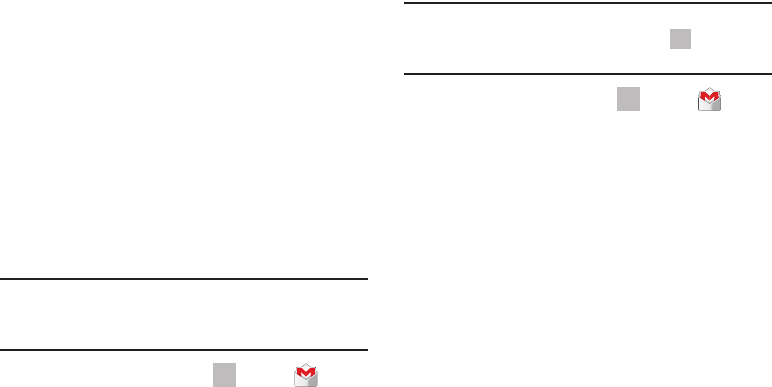
76
•
Require sign-in
: Check this option to enter a username and
password for your SMTP server, if your email service provider
requires that you enter them to send email.
•
User name
: Your username on the SMTP server (this may not be
the same as your username on the POP3 or IMAP server for
incoming mail). Visible only if Require sign-in is checked.
•
Password
: Your password on the SMTP server (this may not be the
same as your username on the POP3 or IMAP server for incoming mail).
Visible only if Require sign-in is checked.
Gmail
Send and receive email with Gmail, Google’s web-based
email.
Tip:
To set up your Google account on your device, use
Accounts and sync
settings. (For more information, refer to
“Accounts” on page 198.)
䡲
From a Home screen, touch
Apps
➔
Gmail
.
Setting Up Your Gmail Account
If you did not set up a Google account during the initial
configuration, the first time you launch Gmail, your device
prompts you to set up your Google account.
Note:
You can use more than one Google account on your
device. To add another account, touch
Menu
➔
Settings
➔
ADD ACCOUNT
.
1. From a Home screen, touch
Apps
➔
Gmail
.
The Add a Google Account screen displays.
2. Touch
Existing
to sign in to an existing account.
•
At the
Sign in
screen, use the on-screen keyboard to enter
your Google
Email
name and
Password
, then touch
Sign in
.
– or –
Touch
New
to create a new account.
•
At the
Your name
screen, enter your first and last name, and
touch
Next
.
•
At the
Create email address
screen follow the prompts to
create a new account.
The Backup and restore screen displays.
3. Read the backup and restore information, touch the
option to enable or disable it, and then touch
Next
.
DRAFT
FOR INTERNAL USE ONLY
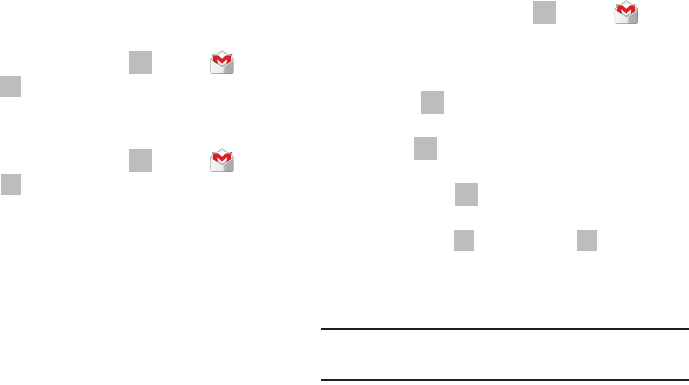
Messaging 77
4. The device communicates with the Google server to set
up your account and synchronize your email. When
complete, your Gmail displays in the Inbox.
Refreshing Your Gmail Account
Refresh your account to update your device from the Gmail
servers.
1. From a Home screen, touch
Apps
➔
Gmail
.
2. Touch
Refresh
in the Application Bar.
Managing Your Gmail Account
Use menu options to manage your Gmail account.
1. From a Home screen, touch
Apps
➔
Gmail
.
2. Touch
Menu
for these options:
• Manage labels
: Determine settings for each label.
•Settings
: Configure settings. For more information, refer to
“Gmail Account Settings”
on page 79.
•Help
: Learn about using Gmail.
• Send Feedback
: Fill out a Google feedback form.
Managing Your Gmail Conversations
In addition to managing your Gmail account, there are
options for changing the status of one or more Gmail
conversations in an account.
1. From a Home screen, touch
Apps
➔
Gmail
.
2. Touch the gray box to the left of one or more
conversations and then choose one of the following
options:
•Archive
: Archive the conversations. Archived
conversations are assigned to the All Mail folder.
• Delete
: Delete the conversations. Deleted conversations
are moved to the Trash folder.
• Change labels
: Relocate the conversations to the
Inbox
,
Personal
,
Receipts
,
Travel
, or
Work
folder and then touch
OK
.
• Mark as Read
/
Mark as Unread
: Mark the
conversations as read or unread. Once a conversation is
marked as read, it has a gray background. Touch
DONE
to
remove the check marks.
Tip:
To move a conversation to another folder, touch and drag
it to the folder tab.
DRAFT
FOR INTERNAL USE ONLY
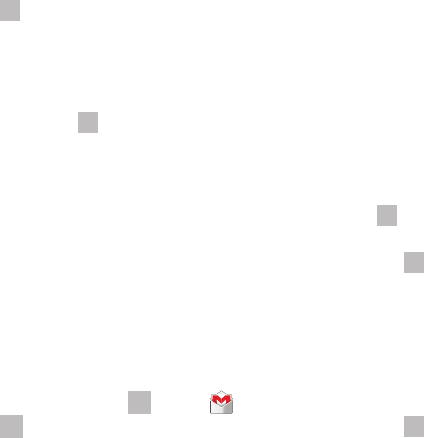
78
3. Touch
Menu
for these options:
•Add star
/
Remove star
: Mark (or unmark) conversations with
a yellow star. Starred conversations are listed in the Starred
folder. Touch
DONE
to remove check marks.
• Mark important
/
Mark not important
: Change the
importance indicator . Yellow indicates important.
•Mute
: New messages added to muted conversations bypass
your inbox so that the conversation stays archived in the All
Mail folder.
•Report spam
: Report the conversations as spam, which is
email that violates the Gmail Program Policies and/or Terms of
Use.
• Settings
: Configure settings. For more information, refer to
“Gmail Account Settings”
on page 79.
•Help
: Learn about using Gmail.
• Send feedback
: Fill out a Google feedback form.
Composing and Sending Gmail
1. From a Home screen, touch
Apps
➔
Gmail
.
2. Touch
Compose
.
3. Touch the
To
field to enter recipients. As you enter
names or email addresses, matching contacts display.
Touch a contact to add it to the field.
4. Touch the
Subject
field to enter a subject.
5. Touch
Compose email
to enter the text of your email.
6. While composing a message, the following options are
displayed:
• + CC/BCC
: Create Cc (copy) and Bcc (blind copy) fields in the
message. After creating the fields, touch to enter recipients.
• Attach
: Launch Gallery to select a photo to add to the
message.
7. Touch
Menu
for the following options:
• Settings
: Configure settings. For more information, refer to
“Gmail Account Settings”
on page 79.
•Help
: Learn about using Gmail.
• Send feedback
: Fill out a Google feedback form.
8. Touch
SEND
to send this message.
– or –
Touch
Menu
➔
Save draft
to save a draft of this
message.
DRAFT
FOR INTERNAL USE ONLY

Messaging 79
Gmail Account Settings
1. From a Home screen, touch
Apps
➔
Gmail
.
2. Touch
Menu
➔
Settings
for settings:
General settings
• Confirm before deleting
: Have your device prompt you to
confirm Delete actions.
• Confirm before archiving
: Have your device prompt you to
confirm archiving actions.
• Confirm before sending
: Have your device prompt you to
confirm Send actions.
• Auto-advance
: Choose a screen to show after you delete or
archive a conversation.
• Message text size
: Set the size of text in message displays.
• Clear search history
: Remove previous searches you
performed.
• Hide pictures in messages
: Stops pictures from displaying
automatically in messages until you allow it for a sender.
(Gmail account settings)
Each account has independent settings:
• Priority Inbox
: This setting is only available if you have
configured Gmail on the web to show Priority Inbox. If available,
you can set Priority Inbox as the conversation list to open when
you have new mail, rather than Inbox.
• Email notifications
: When enabled, notifications for new email
appear in the Status Bar.
•Ringtone & vibrate
: If Email notifications is enabled, touch this
field to set the following options:
–
Sync messages
: Sync options are: None, Last 30 days, or All.
–
Email notifications
: When enabled, notifications for new email
appear in the Status Bar.
–
Ringtone
: Choose a ringtone for new email notifications or use
the default ringtone and then touch
OK
.
–
Notify once
: When enabled, a notification appears in the Status
Bar for new email, not for every new message.
•Signature
: Create a text signature to add to outgoing
messages.
• Gmail sync is ON/OFF
: Indicates whether you have Gmail
synchronization turned on for this account in the
Account and
sync
settings. Touch to open those settings.
DRAFT
FOR INTERNAL USE ONLY
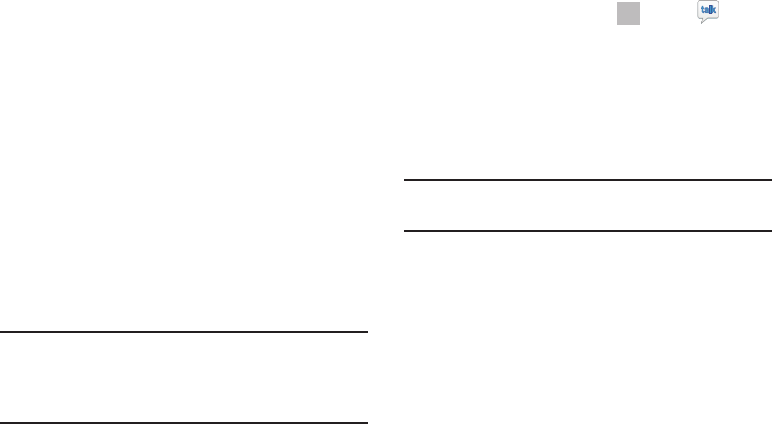
80
• Days of mail to sync
: Set the number days to sync email for
this Gmail account.
• Manage labels
: Choose which labels are synchronized.
• Download attachments
: Enable or disable auto-download of
files attached to recent messages when connected through
Wi-Fi.
About Gmail
•
Displays information about the Gmail (Version, copyright
information, Send feedback, Report a problem, Open source
licenses, Privacy Policy).
Google Talk
Talk is Google’s instant messaging and audio and video chat
service. You can use it to communicate, in real time, with
other people who also use Google Talk on another Android
tablet or phone or on a computer.
Tip:
Talk requires that you have a Google account. To set up
your Google account on your device use
Accounts and
sync
settings. (For more information, refer to “Accounts”
on page 198.)
Open Talk and Sign In
1. From a Home screen, touch
Apps
➔
Talk
.
If you are not signed in to a Google account, the Add a
Google Account screen displays.
2. Touch
Existing
, if you already have a Google account,
or
New
to create a Google account.
For more information, refer to “Setting Up Your Gmail
Account” on page 76.
Note:
If you have already set up your Google account, you are
automatically logged in. Just touch the account.
Once sign in is complete, the Talk main screen
displays.
DRAFT
FOR INTERNAL USE ONLY

Messaging 81
Invite a Friend to Chat
You can invite anyone with a Google Account to become your
friend in Google Talk, so you can chat with each other and
view each other’s online status.
1. While viewing your Friends list, touch
Add friend
.
2. Enter your friend’s address and touch
DONE
.
Your friend’s address in Talk is a Gmail or other email
address that is configured to connect to Google Talk.
If your friend accepts your invitation, they are added to
your Friends list in Talk and you can share each others
status in Talk and other applications.
View and Accept an Invitation to Become a
Friend
When a contact invites you to become a friend in Google Talk,
you receive a notification in the System Bar and the
invitation displays in your Friends list.
1. Touch the invitation.
2. Touch
Accept
, if you want to accept the invitation and
chat,
Decline
, if you do not want to chat with and share
your Google Talk status with the sender right now, or
Block
, if you do not want to receive any more
invitations from that person.
If you touch
Accept
, the friend is added to your Friends
list in Talk and you can share your status in Talk and
other applications.
Talk Options
There are several options that are available while viewing
your Friends list and some that are only available while you
are chatting.
1. Touch to search your Talk messages or the current
message for a word. Use the on-screen keyboard to
enter a search term. Touch on the keyboard to
search your Talk messages.
2. Touch
to invite another friend to chat, to
invite a friend to video chat, or to invite a friend to
voice chat.
DRAFT
FOR INTERNAL USE ONLY

82
3. Touch a Friend’s entry to display the Chat entries for
that Friend.
4. Touch
Menu
to display the following options,
which are available while viewing your Friends list and
some that are only available while you are chatting.
•Display options
: To set the way your friends list is sorted,
touch
Availability
,
Name
, or
Recency
.
• End all chats
: End all chats in which you are engaged.
•Sign out
: Sign out of Google Talk and display the Talk main
screen.
•End chat
: End this chat session.
• Go off the record/Stop chatting off the record
: Set whether
you want to stop saving your chat to the chat history.
•Friend info
: Display information about the friend with which
you are chatting. The following options are also displayed:
–
BLOCK
: Keeps this person from sending you messages and
removes the person from your Friends list.
–
REMOVE
: Remove the friend as if you never accepted their
invitation. However, the friend is not blocked.
Note:
If you touch the
REMOVE
option, touch
Add friend
➔
Send chat invitation to,
to make the Friend visible again.
•Add to chat
: Choose another friend to invite to this
conversation.
• Clear chat history
: Remove the history of this chat from your
device.
• Settings
: Offers various settings for Google talk. For more
information, refer to
“Google Talk Settings”
on page 82.
•Help
: Displays additional help information.
• Send feedback
: Fill out a Google feedback form.
Google Talk Settings
Use Google Talk Settings to configure your Talk account. If
you have more than one account, each maintains its own
Talk settings.
1. From a Home screen, touch
Apps
➔
Talk
.
DRAFT
FOR INTERNAL USE ONLY

Messaging 83
2. Touch
Menu
➔
Settings
, then touch an account for
options:
GENERAL
• Mobile indicator
: Check and your friends see an outline of an
android next to your name in their Friends list when you are
signed into Google Talk on a tablet or phone.
• Away when screen off
: Check to change your Talk status to
Away when your screen turns off. When unchecked, your
status is not changed.
• Invitation notifications
: Show notification when a friend
invitation arrives.
CHAT NOTIFICATIONS
• IM notifications
: Set whether to open a dialog, display a
notification in the System Bar, or neither, when you receive a
text chat.
• Notification ringtone
: Set a ringtone to sound, or silent, when
you receive a text chat.
VOICE & VIDEO CHAT
• Video chat notifications
: Set whether to open a dialog or
display a notification in the System Bar when you are invited to
a video chat.
• Video chat ringtone
: Set a ringtone to sound, or silent, when
you receive an invitation to a video chat.
• Default video effect
: Set the video image stabilization.
ACCOUNT
• Blocked friends
: Displays a list of friends you have blocked.
Touch a blocked friend and then touch OK to unblock the
friend.
• Clear search history
: Erases your search history. No previous
searches are shown until you search for new words.
• Manage account
: Opens the Accounts and sync settings. (For
more information, refer to
“Accounts”
on page 198.)
ABOUT
•Terms & privacy
: Displays the Google Talk terms of use and
privacy policies.
DRAFT
FOR INTERNAL USE ONLY

84
Google+
Google+ makes messaging and sharing with your friends a
lot easier. You can set up Circles of friends, visit the Stream
to get updates from your Circles, use Messenger for fast
messaging with everyone in your Circles, or use Instant
Upload to automatically upload videos and photos to your
own private album on Google+.
1. Sign in to your Google account. For more information,
refer to “Setting Up Your Gmail Account” on page 76.
2. From a Home screen, touch
Apps
➔
Google+
.
3. Select the account to use to sign in to Google+.
– or –
Touch
Add account
to create another account.
The Enrich your contacts screen displays.
4. Follow the on-screen instructions to use Google+.
5. Visit
www.google.com/mobile/+/
for more information.
Messenger
With Google Messenger, you can bring groups of friends
together into a simple group conversation, putting everyone
on the same page. When you get a new conversation in
Messenger, Google+ sends an update to your tablet.
To get started, touch the Messenger icon on the home screen
of the Google+ app or use the Messenger icon on your
Applications screen.
1. From a Home screen, touch
Apps
➔
Messenger
.
The Messenger screen displays.
2. Sign in to your Google account if you are not already
signed in. For more information, refer to “Setting Up
Your Gmail Account” on page 76.
3. Select the account you want to use to sign in to
Google+.
– or –
Touch
Add account
to create another account.
The Enrich your contacts screen displays.
4. Follow the on-screen instructions to use Messenger.
DRAFT
FOR INTERNAL USE ONLY

Messaging 85
Note:
Uploading over a mobile network uses a data connection
and charges may apply.
5. Touch
Menu
➔
Help
and then touch a topic to
learn more about using Google Messenger.
DRAFT
FOR INTERNAL USE ONLY
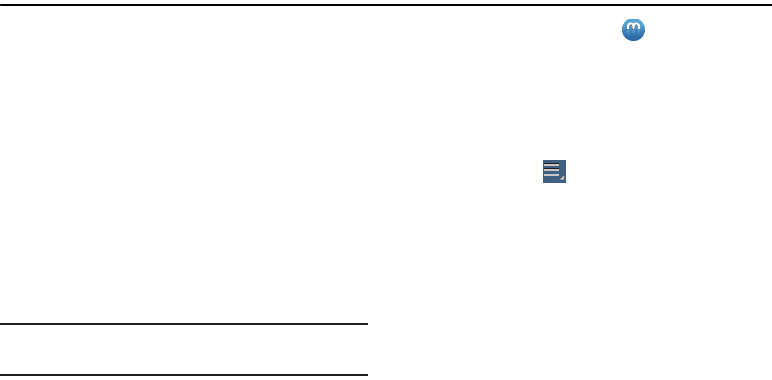
86
Section 6: Multimedia
This section describes the various multimedia applications
available on your device such as Media Hub, Music Player,
Google Play Music, Video Player, Play Movies & TV, Gallery,
Camera, Camcorder, and Photo Editor.
For more information, refer to “Applications and Widgets” on
page 134.
Media Hub
Samsung Media Hub is your one stop for the hottest movie
and TV content. With hundreds of titles available at your
finger tips, entertaining on the go has never been easier. You
can rent or purchase your favorite content and conveniently
watch anywhere. Featuring the stunning viewing quality
Samsung is known for, Samsung Media Hub is your gateway
to mobile video like you have never experienced it before.
Note:
Media Hub service requires a Samsung account and
depends on service availability.
1. From the
Apps
screen, touch
Media Hub
.
2. Read the End-User License Agreement (EULA), touch
I agree to the Terms and Conditions
, and then touch
Accept
to continue or
Decline
to exit.
The Media Hub screen displays.
3. To rent or buy media, you must have a Samsung
account. Touch
Menu
➔
My Profile
to sign in to
your Samsung account or to create an account. Follow
the prompts to complete log-in.
4. Browse content using these options:
•What’s new
: Recently-added titles for rent or purchase.
•Movies
: Movies you can rent or purchase.
• TV Shows
: TV shows you can rent or purchase.
•My Media
: Content you have previously purchased or rented.
DRAFT
FOR INTERNAL USE ONLY

Multimedia 87
5. When you find media you want to view, use these
options:
•View trailer
: View a short clip from the movie or show.
•Buy
: Purchase the media for unlimited viewing on your device.
Follow the prompts to enter payment details.
•Rent
: Purchase a time-limited download of the media. Follow
the prompts to enter payment details.
6. For additional information about Media Hub, touch
Menu
➔
Help
.
Media Hub Notices
•
Any media item (Media Content) may be rented or purchased after
you create an account in Media Hub.
•
Media Content that is downloaded may be viewed concurrently on
up to five (5) devices with Media Hub that are also registered to
the same account.
•
You may choose to remove a device from your account no more
than once every 90 days.
•
You may remove Media Content from a device as many times as
you like. You will have the ability to re-download the Media
Content at a later point in time subject to content re-download
availability and studio permissions.
•
You MUST be in network coverage to license Media Content you
have acquired through the Service.
•
You can use 3G, 4G, or Wi-Fi connectivity in order to download
Media Content.
•
Unlike purchased Media Content, rented Media Content will be
viewable on only 1 device in your account.
•
Media Content is downloaded and saved onto the SD card.
•
Your Media Content may pause/stop or not download in networks
where there is a weak signal.
•
You may begin watching downloaded Media Content as soon as
a) license acquisition has occurred and b) sufficient amount of the
Media Content has been buffered.
•
You must finish watching rented Media Content within 24
consecutive hours of start of playback.
–
Stopping, pausing, or restarting rented Media Content does not
extend the available viewing time.
DRAFT
FOR INTERNAL USE ONLY

88
–
In no event will rented Media Content be available for a period
of more than thirty (30) days (or shorter on a title-by-title basis)
after the Media Content has been rented (e.g., if you begin
viewing rented Media Content on the 29th day after the rental
transaction, but do not finish viewing the entire title, that rented
Media Content may not be available for the entire twenty-four
(24) consecutive hour period if such period would extend the
viewable time beyond the thirty (30) day rental window).
•
You cannot play any media content downloaded from Media Hub
through any output on your mobile device, including All Share.
Game Hub
Samsung Game Hub is a premium game service that lets
you play, connect and share games. Game Hub comes pre-
packed with popular social games and with a variety of
premium HD games that have been optimized for your
Samsung device with its blazing fast Quad Core processor
and SUPER AMOLED Plus screens.
Note:
Game Hub service requires a Samsung account and
depends on service availability.
1. From the
Apps
screen, touch
Game Hub
. A
Disclaimer
screen appears.
2. Read the Game Hub disclaimer text and press
Confirm
.
The
Game Hub
screen appears showing the following
games menus:
Social Games
, and
Premium Games
, and
Installed games
.
3. For more information, touch
More games
in either the
Social Games
(launches Samsung Apps) or the
Premium
Games
(launches the
More games
pop-up) menu.
DRAFT
FOR INTERNAL USE ONLY
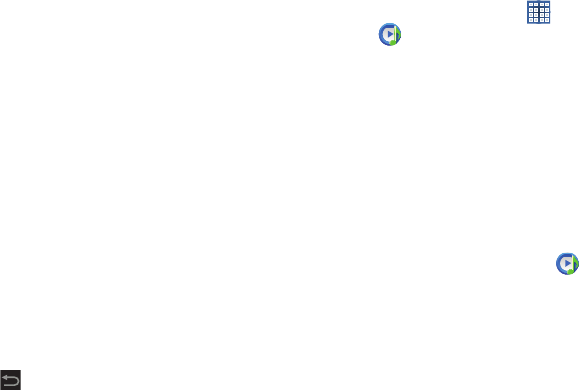
Multimedia 89
4. Follow the prompts to select a game to download. For
each game you select, a
Details
screen appears. The
following options are available:
•Search
:
• Account information
:
• Game categories
:
•Menu
:
–
Settings
:
–
Terms and conditions
:
• Download
:
•Launch
:
•Share
: You can choose to share games over Facebook or
Twitter.
5. To begin downloading the game, touch
Download
. After
downloading completes, the game should be installed
automatically.
6. To begin playing the game:
•
Touch
Launch
.
– or –
•
Touch
Back
, then touch the new game’s icon in the
Installed games
menu.
Music Player
Music Player plays
music and other audio files that you copy from
your computer.
1. From a Home screen, touch
Apps
➔
Music Player
.
The Music Player application searches your device’s
internal storage for music and playlists. This can take
from a few seconds to several minutes, depending on
the amount of new music added since you last opened
the application. It then displays your music in several
ways.
2. Touch
Songs
,
Playlists
,
Albums
,
Artists
,
Genres
,
Folders
,
Composers
,
Years
, or
Music square
to change the way
you view the contents of your library.
3. Touch the Music application icon at the top-left of
the Application bar to return to the previous Music
screen.
Managing Your Music
Searching for Music
To find music in your library:
DRAFT
FOR INTERNAL USE ONLY
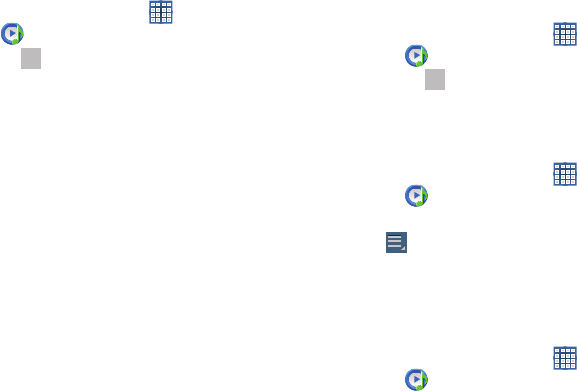
90
1. From a Home screen, touch
Apps
➔
Music Player
.
2. Touch
Search
.
3. Type the name of an artist, album, or song.
Matching songs are displayed in a list below the search
box.
4. Touch a matching song to play it. Touch a matching
album, or artist to view a list of its songs.
Creating a Playlist
1. From a Home screen, touch
Apps
➔
Music Player
➔
Playlists
.
2. Touch
➔
New playlist
.
3. Touch the name field to enter a name for the playlist.
4. Touch
OK
to save the new playlist.
Renaming a Playlist
1. From a Home screen, touch
Apps
➔
Music Player
.
2. Touch
Playlists
, touch a playlist, and then touch
Menu
➔
Rename playlist
.
3. Touch the name field to enter a new name for the
playlist.
4. Touch
OK
to save the new playlist.
Adding Songs to Playlists
1. From a Home screen, touch
Apps
➔
Music Player
.
DRAFT
FOR INTERNAL USE ONLY
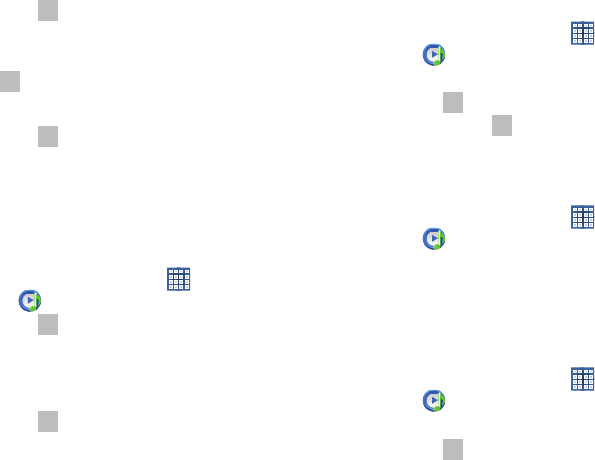
Multimedia 91
2. Touch
and touch a playlist.
– or –
Touch
Playlists
, touch a playlist, and then touch
Add music
.
All songs are displayed.
3. Touch
next to each song you want to add or next to
Add all
to add all songs to the playlist.
The songs appear under the playlist to the right of the
songs list.
4. Touch
Done
to save the playlist.
Removing Songs from Playlists
1. From a Home screen, touch
Apps
➔
Music Player
.
2. Touch
and touch a playlist.
All songs are displayed to the left of the playlist and the
songs in the playlist are displayed on the right, under
the playlist name.
3. Touch
to remove a song from the playlist.
4. Touch
Done
to save the playlist.
Changing the Order of a Playlist
1. From a Home screen, touch
Apps
➔
Music Player
.
2. Touch
Playlists
and touch a playlist.
3. Touch
Reorder
to change the order of the songs.
Touch the grid on an entry and drag the entry to a
new position in the list.
4. Touch
Done
to change the order and save the playlist.
Playing a Playlist
1. From a Home screen, touch
Apps
➔
Music Player
.
2. Display the
Playlists
library view.
3. Touch
Favorites
,
Most played
, or
Recently added
, or
touch a playlist title that you created.
4. Touch a song to start playing the playlist at that song.
Deleting a Playlist
1. From a Home screen, touch
Apps
➔
Music Player
.
2. Touch
Playlists
and touch a playlist.
3. Touch
Delete
in the Application bar.
DRAFT
FOR INTERNAL USE ONLY

92
4. Touch the box next to a playlist title. A check mark
indicates the playlist is to be deleted.
5. Touch
Remove
and then touch
OK
to delete the selected
playlist.
Changing Music Settings
To change settings in the Music application:
1. From a Home screen, touch
Apps
➔
Music Player
.
2. Touch
Menu
to display the following options:
•Delete
: Touch the box for any song or album you want to delete
or touch the box for
Select all
to select every song or album. A
check mark indicates the song or album is to be deleted.
Touch
Delete
to delete the selected items.
•Share via
: Share your music by using Group Cast, Bluetooth,
Wi-Fi Direct, Gmail, or Email. Select the songs you want to
share and touch
Share
.
• Set as alarm tone
: Choose a song and touch
Set
to use the
song as an alarm tone.
• Scan for nearby devices
: Discover and connect directly to
nearby devices.
• Settings
: The following settings display:
Advanced
–
Sound settings
: Choose
SoundAlive
and
Play speed
settings.
–
Lyrics
: Display the lyrics of the song, if available.
–
Music auto off
: Set the option Off or set your music to turn off
automatically after 15 minutes, 30 minutes, 1 hour, 1 hour and
30 minutes, or 2 hours.
Music menu
–
Music menu
: Enable or disable the music display options that
appear on the main music screen. A check mark
next to
an option means that it is enabled.
Listening to Music
You can listen to music by using your device’s built-in
speakers, through a wired headset or through a wireless
Bluetooth stereo headset.
For more information, refer to “Bluetooth” on page 122.
Touch the
Volume Key
on the side of the
device to activate on-screen volume control, then touch and
drag on the scale to set volume. You can also press the
Volume Key to adjust playback volume.
DRAFT
FOR INTERNAL USE ONLY
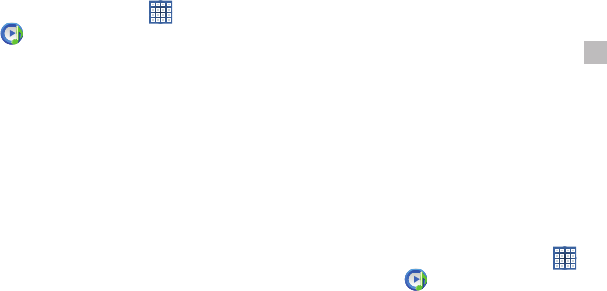
Multimedia 93
Playing Music
To play a song:
1. From a Home screen, touch
Apps
➔
Music Player
.
2. Touch a song in your library to listen to it.
– or –
While viewing a list of albums or genres, touch the
album thumbnail and then touch a song in the list of
songs on the album.
The song you touch starts to play. The tracks in the
current list play in order until you reach the end of the
list (unless you choose a repeat option). Otherwise,
playback stops only if you stop it, even when you
switch applications.
Accessing the Music Player
If you navigate away from the
Music Player
application and
music is playing, you can change songs or easily return to
the Music Player:
1. Touch the Music notification icon in the System
Bar.
2. In the Status Details, touch the song title to display the
Music Player. You can also pause and resume playback
and skip to the next or previous song in the panel. For
more information, refer to “Notifications” on page 35.
Using the Music Player
Music Player plays
music and other audio files that you copy from
your computer.
1. From a Home screen, touch
Apps
➔
Music Player
.
2. Touch a song or playlist to begin playback.
The music player displays below (portrait mode) or to
the right (landscape mode) of the music listing.
DRAFT
FOR INTERNAL USE ONLY

94
3. Touch the music player to enlarge it and touch the
screen to display the sound and playlist controls.
4. During playback, use the sound and playlist controls:
•Favorite
: Touch the star to mark the current song as a
favorite.
•Volume
: Touch to toggle Silent mode and Sound mode, then
touch and drag on the scale to set volume. You can also press
the Volume Key on the side of the device to adjust playback
volume.
•SoundAlive
: Touch to view and set SoundAlive options.
•Info
: Touch to view information about the current song.
•List
Mode
: Touch to switch to the list of songs.
•Shuffle
: When enabled, songs play in random order. When
disabled, songs play in the order they appear in List view.
• Progress Bar
: Touch and drag the end of the progress bar to
scan forward or backward through the current song.
• Playback Controls
: These buttons control the playback of
songs:
–
Touch to advance to the next song. Touch and hold to
scan forward through the current song.
–
Touch to go back to the previous song. Touch and hold
to scan backward through the current song.
–
Touch to pause playback. Touch to resume playback.
Info
List
Song Title
Artist /
Favorite Volume
Shuffle Playback Controls Repeat
Progress
Bar
Time
Indicators
SoundAlive Mode
Album
DRAFT
FOR INTERNAL USE ONLY
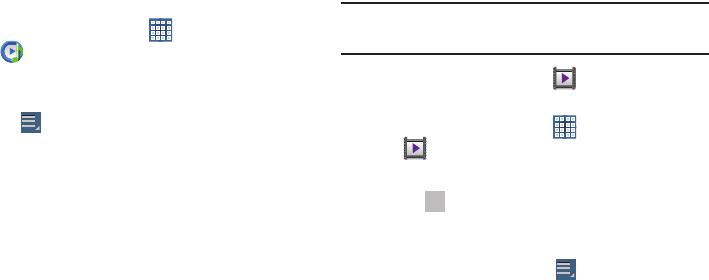
Multimedia 95
•Repeat
: Touch to repeat the current song, repeat all songs, or
disable repeat mode.
Options While Playing a Song
There are various options and controls available while a song
is playing:
1. From a Home screen, touch
Apps
➔
Music Player
, touch a song or an album, and
then a song.
2. Touch the music player to enlarge it.
3. Touch
Menu
to display the following options:
•Add to playlist
: Add the song to a new playlist or an existing
playlist.
• Via Bluetooth
: Play the current song by using a Bluetooth
device.
•Share via
: Share the current song by using Group Cast,
Bluetooth, Wi-Fi Direct, Gmail, or Email.
• Set as alarm tone
: Use the current song as an alarm tone.
• Scan for nearby devices
: Discover and connect directly to
nearby devices.
•Settings
: Displays Music Player settings. For more information,
refer to
“Changing Music Settings”
on page 92.
Video Player
Your device’s 10.1-inch 1280x800 WXGA
TFT (PLS) LCD
screen provides playback of videos. Use Video Player to view
and manage videos stored on your tablet.
Tip:
Video Player displays by default as a Primary shortcut on a
Home screen.
1. From a Home screen, touch
Video Player
.
– or –
From a Home screen, touch
Apps
➔
Video Player
.
2. Touch the
Thumbnails
,
List
, or
Folders
tab.
3. Touch
Search
and use the keyboard to enter a
search term. The current folder is searched and results
are displayed. Touch
X
to remove the search field.
4. While viewing the list, touch
Menu
for options:
•List by
: Display videos by Name (default), Date, Size, or Type.
•Share via
: Share the video with Google+, Bluetooth,
Wi-Fi Direct, YouTube, Gmail, or Email.
DRAFT
FOR INTERNAL USE ONLY

96
•Delete
: Touch videos to select them for deletion or touch
Select all
to delete all videos. Touch
Delete
to deleted the
selected videos.
• Auto play next
: Touch to enable or disable automatic playing of
videos in the order they appear.
• Scan for nearby devices
: Discover and connect directly to
nearby devices.
5. Touch a video to play it. While playing a video, touch
the screen to display or hide on-screen playback
controls.
6. Touch the icon in the upper left corner of the display
screen
while the video is playing
to change the Display
Mode from original size to full screen in ratio or full
screen.
• Original Size
( ): Changes the display mode to the original
size.
• Full-Screen in Ratio View
( ): Changes the display mode
to the full-screen in ratio option. The video is enlarged as much
as possible without becoming distorted.
• Full-Screen View
( ): Changes the display mode to full
screen. That is, the entire screen is used, which may cause
some minor distortion.
7. Touch
SoundAlive
to set the sound quality to
Normal, Voice, Movie, or Virtual 7.1 ch.
8. While the video is playing, touch
Bookmark
to
mark your favorite areas of the video. A yellow mark
displays on the progress bar.
DRAFT
FOR INTERNAL USE ONLY

Multimedia 97
9. During playback, press
Menu
for options:
•Share via
: Send the video by Google+, Bluetooth, Wi-Fi Direct,
YouTube, Gmail, or Email.
• Chapter preview
: If chapter information is recorded in the
video file, display the chapters. Touch a chapter to begin
playing the video at that point.
•Trim
: Trim the original video or trim the video and create a new
video.
• Via Bluetooth
: Turn Bluetooth on to use Bluetooth services.
•Video Maker
: Open this video in the Video Maker app. For
more information, refer to
“Video Editor”
on page 161.
• Bookmarks
: If bookmarks have been set for this video, a
thumbnail and time are displayed for each bookmark. Touch
to remove a bookmark.
•Details
: Provides details about the video, such as Name, Size,
Resolution, Duration, Format, and Date modified.
• Time set for auto video off
: Automatically turn off the video.
Options are: Off, After playing, After 15 min, After 30 min,
After 1 hour, After 1 hour 30 min, or After 2 hours.
• Scan for nearby devices
: Discover and connect directly to
nearby devices.
•Settings
: Touch this option to view the following:
–
Play speed
: Touch and drag the slider to decrease or increase
play speed.
–
Subtitles
: View subtitles for the video, if available.
–
Auto play next
: Enable or disable auto play of the next video.
For more information, refer to “Playing Videos” on page 101.
Play Movies & TV
The Play Movies & TV app is available for select Android
devices. Any movie you rent from the Google Play™ Store
can be downloaded for offline viewing through this
application. In addition, the Play Movies & TV app can be
used to stream your Google Play™ movie rentals as well as
play any of your personal videos stored on your tablet.
1. From a Home screen, touch
Apps
➔
Play Movies & TV
.
2. For more information touch
Menu
➔
Help
.
DRAFT
FOR INTERNAL USE ONLY
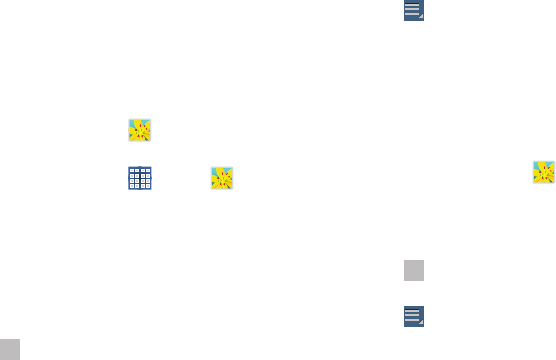
98
Gallery
Your device’s 10.1-inch 1280x800 WXGA
TFT (PLS) LCD
screen
provides a high-resolution
display of photos and videos.
Use Gallery to view, capture, and manage photos and videos.
Selecting Photos and Videos to View
1. From a Home screen, touch
Gallery
.
– or –
From a Home screen, touch
Apps
➔
Gallery
.
All albums display.
2. Touch
Albums
to display other ways to group your
photos and videos. Options are:
•Albums
: Based on the folder in which they are stored.
•Locations
: Based on where taken.
•Time
: Based on the time taken.
3. Touch
Camera
to launch the Camera app.
4. Touch
Menu
to display the following options:
• Select album / Select group:
Touch one or more albums or
groups that you want to share, stream to another device, or
delete.
• Scan for nearby devices
: Discover and connect directly to
nearby devices.
Viewing Groups of Photos and Videos
1. From a Home screen, touch
Gallery
.
2. Touch a category and then a group to view it.
Thumbnails for each photo and video in the group
display.
3. Touch
Slideshow
to view a slideshow of the
available pictures and videos.
4. Touch
Menu
for these options:
• Select item:
Touch one or more items that you want to share,
stream to another device, or delete.
• Group by
: Further group this group by Location, Time, Person,
or Group, depending on the way you chose the group.
DRAFT
FOR INTERNAL USE ONLY

Multimedia 99
Viewing Photos and Videos
1. From a Home screen, touch
Gallery
.
2. Touch a category and then a group to view it, and then
touch a photo or video thumbnail.
3. Touch the screen to show or hide Gallery options.
4. Touch the screen with two fingers or double-tap on the
screen to zoom all the way in or out. For more
information, refer to “Pinch” on page 34.
5. Sweep across the screen to display the next or
previous photo or video. (Videos are indicated by the
Play
button.) The current photo or video is
outlined in the thumbnails at the bottom of the screen.
Touch a thumbnail to view the photo or video it
represents.
6. Touch
Share
to use Group Cast (photos), Picasa
(photos), Photo editor (photos), Google+, Bluetooth,
Wi-Fi Direct, YouTube (videos), Gmail, or Email to share
the photo or video.
7. Touch
Slideshow
to view a slideshow of photos
and video thumbnails in the group. Touch the screen to
stop the slideshow and view the photo or video being
displayed.
8. To delete the photo or video being displayed, touch
Delete
and then touch
OK
to delete the item or
Cancel
to
exit.
9. Touch
Menu
to display the following options for
photos:
•Copy to clipboard
: Copy the current photo to the clipboard.
•Rotate left
: Allows you to rotate the photo counterclockwise 90
degrees.
•Rotate right
: Allows you to rotate the photo clockwise 90
degrees.
•Crop
: Allows you to crop the image. Touch and drag the crop
box or the sides or corners of the crop box to create the crop
area, then touch
Done
. Touch
X
to stop without cropping the
photo.
•Edit
: Use Photo studio or Video Maker to edit your photo or
video.
DRAFT
FOR INTERNAL USE ONLY
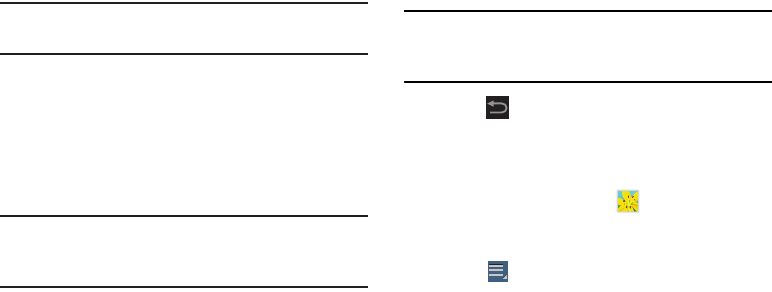
100
•Set as
: Assign the photo as a Contact photo, Home screen,
Lock Screen, or Home and lock screens.
•Print
: Print the current photo to a Samsung printer.
•Show on map
: This option displays if a Location exists for the
photo. A Location is added to the photo if
GPS tag
is set
On
in
the Camera settings. Touch this option to open the Map app
and display the Location where the photo was taken. For more
information, refer to
“Camera Settings”
on page 103.
Caution!
Be aware that your location may be present on a
photo when posting your photos on the Internet.
•Rename
: Enter an new file name.
• Scan for nearby devices
: Discover and connect directly to
nearby devices.
•Details
: Provides details about the photo such as Title, Time,
Location, Width, Height, File Size, and so on. Touch the
Close
to close the pop-up.
Note:
Photos are stored in the /Root/sdcard/DCIM/Camera
folder as jpg files. For more information, refer to “My
Files” on page 153.
There is only two options for videos that are not
playing:
•Rename
: Enter an new file name.
•Details
: Provides details about the video such as Title, Time,
Duration, File Size, and so on. Touch the
Close
to close the
pop-up.
For menu options while a video is playing and other
video options, see “Video Player” on page 95.
Note:
Videos are stored in the /Root/sdcard/DCIM/Camera
folder as mp4 files. For more information, refer to “My
Files” on page 153.
10. Press
Back
to return to the category screen.
Setting a Picture As
You can use the photos you take as a contact’s photo or as
wallpaper for the Home or Lock screen:
1. From a Home screen, touch
Gallery
.
2. Touch a category and then a group to view it, and then
touch a photo to select it.
3. Touch
Menu
➔
Set as
.
DRAFT
FOR INTERNAL USE ONLY

Multimedia 101
4. Touch
Contact photo
and then touch a contact entry.
– or –
Touch
Home and lock screens
,
Home screen wallpaper
,
or
Lock screen wallpaper
.
The
Crop picture
screen displays.
5. Touch and drag the crop box or the sides or corners of
the crop box to create the crop area, then touch
Done
to save the cropped photo as the contact’s icon or
wallpaper. Touch
Cancel
to stop without cropping the
photo.
Tip:
To remove a contact photo, see “Updating Contacts” on
page 59.
Tip:
To change wallpaper, see “Wallpapers” on page 43.
Playing Videos
1. From a Home screen, touch
Gallery
.
2. Touch a category and then a group to view it, and then
touch a video thumbnail to play the video.
Note:
Videos are marked with a
Play
button.
3. Touch
Pause
to pause the video.
4. Touch
Resume
to resume playing the video.
5. Touch and drag the white dot on the progress
bar to fast forward or rewind the video. Touch the left
end of the progress bar to restart the video. Touch the
right end of the progress bar to end the video playback.
– or –
Touch
Rewind
to restart the video or
Fast Forward
to end the video.
For more information, refer to “Video Player” on
page 95.
DRAFT
FOR INTERNAL USE ONLY
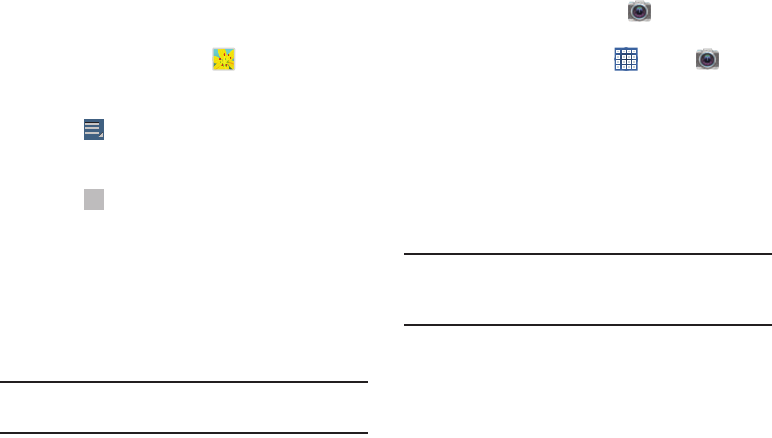
102
Sharing Photos and Videos
Share photos and videos with your friends.
1. From a Home screen, touch
Gallery
.
2. Touch a category and then a group to display
thumbnails.
3. Touch
Menu
➔
Select item
.
4. Touch one or more photos and videos to highlight them
for sharing.
5. Touch
Share
.
6. Touch
Group Cast
(photos only),
Picasa
(photos only),
Photo editor
(photos only),
Google+
,
Bluetooth
,
Wi-Fi Direct
,
YouTub e
(videos only),
Gmail
, or
Email
,
then follow the prompts.
Camera
Use your device’s built-in camera and camcorder to take
photos and record videos.
Tip:
Camera displays by default as a Primary shortcut on the
Home screen.
1. From the Home screen, touch
Camera
.
– or –
From a Home screen, touch
Apps
➔
Camera
.
If a memory card is inserted, the Storage setting
pop-up displays.
2. Touch
OK
to change the storage setting to memory
card.
– or –
Touch
Cancel
to use the device storage for storing
pictures and videos.
Note:
If memory card storage is used, photos are stored in the
/Root/extSdCard/DCIM/Camera folder as jpg files. For
more information, refer to “My Files” on page 153.
DRAFT
FOR INTERNAL USE ONLY
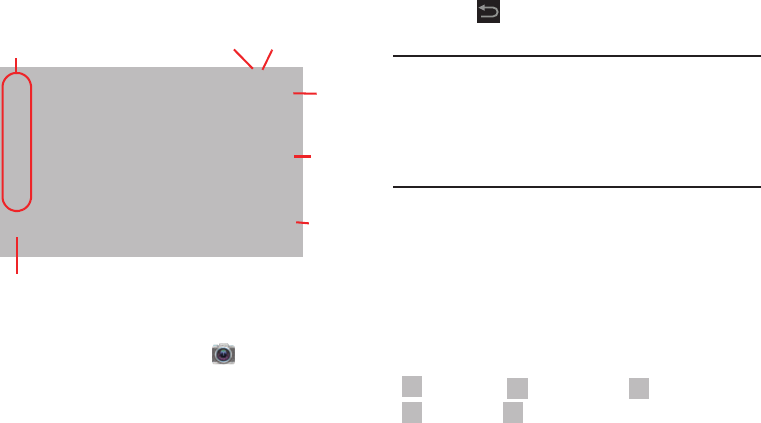
Multimedia 103
The Camera screen displays.
Taking Photos
To take a photo:
1. From the Home screen, touch
Camera
.
2. Using the display as a viewfinder, compose your
picture by aiming the lens at the subject.
To configure settings, see “Camera Settings” on
page 103.
3. To take the photo, touch the
Camera
button.
4. Touch
Back
to leave the Camera and display the
previous screen.
Important!
Do not take photos of people without their
permission.
Do not take photos in places where cameras are
not allowed.
Do not take photos in places where you may
interfere with another person’s privacy.
Camera Settings
Before you start taking photos, use the camera settings to
configure the camera for best results. Camera settings are
represented by icons on the left side of the screen.
Editing Camera Settings Shortcuts
The first five icons are actually shortcuts to camera settings.
These five shortcuts can be customized to fit your
preference.
Self-portrait
,
Shooting mode
,
Timer
,
Effects
, and
Exposure value
are default settings
shortcuts.
Settings
Image
Mode
Camera
Viewer
Storage
Indicator
Settings
Shortcuts
GPS
Active
DRAFT
FOR INTERNAL USE ONLY

104
To customize these shortcuts:
1. Touch
Settings
➔
Edit shortcuts
.
– or –
Touch and hold any of the shortcut icons to edit them.
2. Touch and hold a setting, then drag and drop it on one
of the five settings shortcuts to the left. The replaced
setting shortcut displays in the edit list.
Configuring Camera Settings
To configure Camera settings:
䡲
While in Camera mode, touch a settings shortcut or
touch
Settings
to configure the following camera
settings:
• Edit shortcuts
: Customize your settings shortcuts. For more
information, refer to
“Editing Camera Settings
Shortcuts”
on page 103.
•Self-portrait
: Touch to switch to the front-facing camera lens
and take a photo of yourself.
• Shooting mode
: Choose an automatic shooting mode, from:
–
Single shot
: Take a single photo.
–
Smile shot
: Touch the Camera button to automatically focus on
the subject’s face and take the photo.
–
Panorama
: Touch the Camera button to take a photo, then use
the on-screen guideline to move the viewfinder and take the
next 7 shots automatically.
• Scene mode
: Choose an automatic scene mode from None,
Landscape, Night, Sports, Party/Indoor, Beach/Snow, Sunset,
Dawn, Fall Color, Firework, Candlelight, or Backlight.
•Exposure value
: Use the slider to set the exposure value from
-2.0 to +2.0.
•Timer
: Set a timer for how long to wait before taking a photo.
Options are: Off, 2 sec, 5 sec, and 10 sec.
• Effects
: Apply an effect to photos. Options are: No effect,
Negative, Black and white, or Sepia.
DRAFT
FOR INTERNAL USE ONLY

Multimedia 105
•Resolution
: Set a size for the image. Options are: 3.2M
(2048x1536), w2.4M (2048x1152), 2M (1600X1200),
w1.3M (1536x864), 1.3M (1280x960), w0.9M (1280x720),
or 0.3M (640x480).
• White balance
: Set the light source. Options are: Auto,
Daylight, Cloudy, Incandescent, or Fluorescent.
• Metering
: Set how the camera measures or meters the light
source: Center-weighted, Spot, or Matrix.
• Guidelines
: Enable or disable an on-screen grid to aid in photo
composition.
•GPS tag
: Enable or disable tagging of photos with your GPS
location. displays on the screen when this option is active.
Caution!
Be aware that your location may be present on a
photo when posting your photos on the Internet.
• Shutter sound
: Enable or disable a shutter sound when
you take a photo. Options are: Off or On.
•Storage
: Set whether to store photos on your device or on your
memory card.
• Reset
: Reset all Camera settings to the defaults. Touch
OK
.
Viewing Photos with the Image Viewer
After taking a photo, use the Image Viewer to view, share,
delete, or edit photos.
1. Touch
Image Viewer
to view the photo.
2. Touch the screen to show or hide Image Viewer
options.
3. Touch the screen with two fingers or double-tap on the
screen to zoom all the way in or out. For more
information, refer to “Pinch” on page 34.
4. Sweep across the screen to display the next or
previous photo. The current photo is outlined in the
thumbnails at the bottom of the screen. Touch a
thumbnail to view the photo it represents.
5. Touch
Share
to use Group Cast, Picasa, Photo
editor, Google+, Bluetooth, Wi-Fi Direct, Gmail, or
Email to share the photo.
6. Touch
Slideshow
to display a slide show of the
available pictures and videos.
7. To delete the photo being displayed, touch
Delete
and then touch
OK
to delete the photo or
Cancel
to exit.
DRAFT
FOR INTERNAL USE ONLY
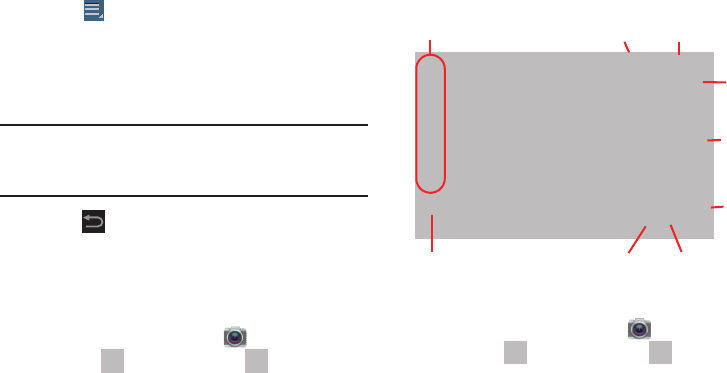
106
8. Touch
Menu
to select
Set picture as
to assign the
photo as a Contact photo, Home and lock screens,
Home screen wallpaper, or Lock screen wallpaper.
For more information, refer to “Viewing Photos and
Videos” on page 99.
Note:
Photos are stored in the /Root/sdcard/DCIM/Camera
folder as jpg files. For more information, refer to “My
Files” on page 153.
9. Press
Back
to return to the Camera to take more
photos.
Camcorder
Use your device’s built-in Camcorder to record high-
definition video in 1080p resolution.
1. From the Home screen, touch
Camera
.
2. Slide the
Mode
button to the
Camcorder
setting.
The Camcorder screen displays.
Recording Videos
1. From the Home screen, touch
Camera
.
2. Slide the
Mode
button to the
Camcorder
setting.
3. Using the display as a viewfinder, compose your shot
by aiming the lens at the subject.
To configure settings, see “Camcorder Settings” on
page 107.
Record
Current or
Elapsed Time
Settings
Shortcuts
Settings
Image
Viewer
Mode
Storage
Indicator
File Size Available
Storage
DRAFT
FOR INTERNAL USE ONLY

Multimedia 107
4. To start recording, touch
Record
.
During recording, a white square appears on the
Record
button.
5. Touch
Record
to stop recording.
6. Touch
Back
to leave the Camcorder and display
the previous screen.
Important!
Do not take videos of people without their
permission.
Do not take videos in places where cameras are
not allowed.
Do not take videos in places where you may
interfere with another person’s privacy.
Camcorder Settings
Before you start taking videos, use the camcorder settings to
configure the camcorder for best results. Camcorder settings
are represented by icons on the left side of the screen.
Editing Camcorder Settings Shortcuts
As with the camera, the first five icons are actually shortcuts
to camcorder settings. These five shortcuts can be
customized to fit your preference.
Self-recording
,
Recording mode
,
Timer
,
Effects
, and
Exposure value
are default settings
shortcuts.
To customize these shortcuts, see “Editing Camera Settings
Shortcuts” on page 103.
Configuring Camcorder Settings
To configure Camcorder settings:
䡲
While in Camcorder mode, touch a settings shortcut or
touch
Settings
to configure the following
Camcorder settings:
• Edit shortcuts
: Customize your settings shortcuts. For more
information, refer to
“Editing Camera Settings
Shortcuts”
on page 103.
• Self-recording
: Touch to switch to the front-facing camera
lens and record a video of yourself.
DRAFT
FOR INTERNAL USE ONLY

108
• Recording mode
: Set a recording mode. Options are: Normal
and Limit for email, which limits the size of the video to 50
megabytes.
•Exposure value
: Use the slider to set the exposure value from
-2.0 to +2.0.
•Timer
: Set a timer for how long to wait before recording a
video. Options are: Off, 2 sec, 5 sec, and 10 sec.
• Effects
: Apply an effect to videos. Options are: No effect,
Negative, Black and white, or Sepia.
•Resolution
: Set a size for the video. Options are: 1280x720,
720x480, 640x480, or 320x240.
• White balance
: Set the light source. Options are: Auto,
Daylight, Cloudy, Incandescent, or Fluorescent.
• Guidelines
: Enable or disable an on-screen grid to aid in video
composition.
•Storage
: Set whether to store you videos on your device or on
your memory card.
• Reset
: Reset all Camera settings to the defaults. Touch
OK
.
Viewing Videos with the Image Viewer
After recording a video, use the Image Viewer to play, share,
or delete your video.
1. Touch
Image Viewer
to view the video.
2. Touch the screen to show or hide Image Viewer
options.
3. Sweep across the screen to display the next or
previous video. The current video is outlined in the
thumbnails at the bottom of the screen. Touch a
thumbnail to view the video it represents.
4. Touch
Share
to use Google+, Bluetooth, Wi-Fi
Direct, YouTube, Gmail, or Email to share the video.
5. Touch
Slideshow
to display a slide show of the
available pictures and videos.
6. To delete the video being displayed, touch
Delete
and then touch
Delete
to delete the video or
Cancel
to
exit.
DRAFT
FOR INTERNAL USE ONLY
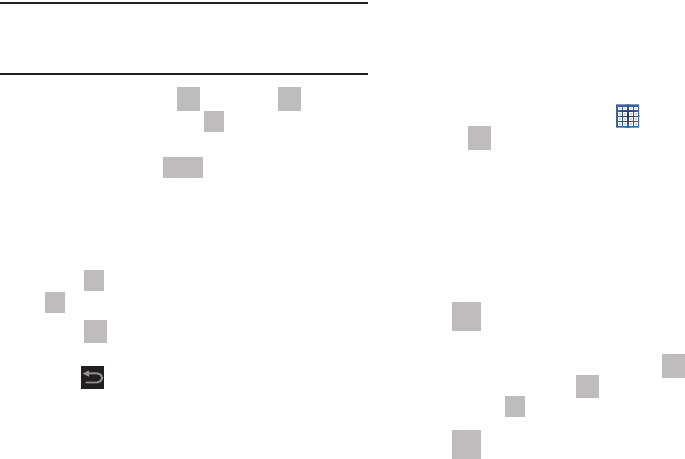
Multimedia 109
Note:
Videos are stored in the /Root/sdcard/DCIM/Camera
folder as mp4 files. For more information, refer to “My
Files” on page 153.
7. To play a video, touch
Play
. Touch
Pause
to
pause the video and touch
Resume
to resume
playing the video.
8. Touch and drag the white dot on the progress
bar to fast forward or rewind the video. Touch the left
end of the progress bar to restart the video. Touch the
right end of the progress bar to end the video playback.
– or –
Touch
Rewind
to restart the video or
Fast Forward
to end the video.
9. Touch
SoundAlive
to set the sound quality to
Normal, Voice, Movie, or Virtual 7.1 ch.
10. Press
Back
to return to the Camcorder.
For more information, refer to “Video Player” on page 95.
Photo Editor
The Photo editor application provides basic editing functions
for photos that you take on your device. Along with basic
image tuning like brightness, contrast, and color, it also
provides a wide variety of effects used for editing the photo.
1. From a Home screen, touch
Apps
➔
Photo editor
.
2. Touch
Select picture
to edit a photo in your Gallery.
– or –
Touch
Take picture
to take a photo with the camera.
3. Touch the photo to load it into the Photo editor.
4. Use the following Photo editor controls to edit your
photo:
Selection
: Touch the selection icon and then
touch
Magnetic
,
Lasso
,
Brush
,
Round
, or
Square
to set how to mark an area for cropping,
rotating, and so on. Touch to select a
single area, to add to a selected area, or
to remove part of a selected area.
Selection Size
: Set the size of the Grab selection
area. Drag the slider from small to large.
DRAFT
FOR INTERNAL USE ONLY

110
5. When all updates to the photo have been made, touch
Save
. Use the keyboard to name the edited photo
and touch
OK
to save it.
6. While editing a photo, touch
Menu
to display the
following options:
• Select picture
: Open a new photo for editing.
• Take picture
: Open the Camera and take a new photo.
•Share via
: Send photos to another device or another person.
Options are: Bluetooth, Email, Gmail, Google+, Group Cast,
Picasa, or Wi-Fi Direct.
•Set as
: Use this photo as a
Contact photo
, a
Home and lock
screens
,
Home screen wallpaper
, or
Lock screen wallpaper
image.
Inverse
: Select the entire picture except for the
selected area.
Undo
: Remove the last change.
Redo
: Restore a removed change.
Rotate
: Rotate a photo to the left or to the right
or create a mirror image of the photo.
Resize
: Touch and then drag the corners of the
photo to resize it.
Crop
: Touch to crop (cut-out) an area of a photo.
Color
: Set the
Auto adjustment
,
Exposure
,
Saturation
,
Contrast
,
Brightness
, and
Hue
of a
photo. You can also make it
Grey-scale
or add
a
Temperature
effect.
Effects
: Add various effects to your photo, such
as
Blur
,
Motion
,
Distortion
,
Filter
, or
Frames
.
Tools
: Copy and Paste to another image or to
the original image. You can use the Spot
healing option.
DRAFT
FOR INTERNAL USE ONLY
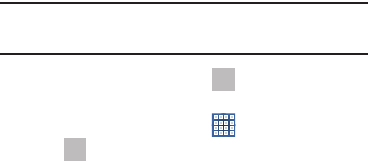
Multimedia 111
Games
Real Racing 2
Real Racing 2 is a high definition, 3D racer that has you
racing as a Rookie on a racing circuit.
Tip:
A shortcut to Real Racing 2 displays on a Home screen by
default.
1. From a Home screen, touch
Real Racing 2
.
– or –
From a Home screen, touch
Apps
➔
Real Racing 2
.
2. The first time you access this game touch
DOWNLOAD
to download the game and play.
3. Enjoy the game!
DRAFT
FOR INTERNAL USE ONLY
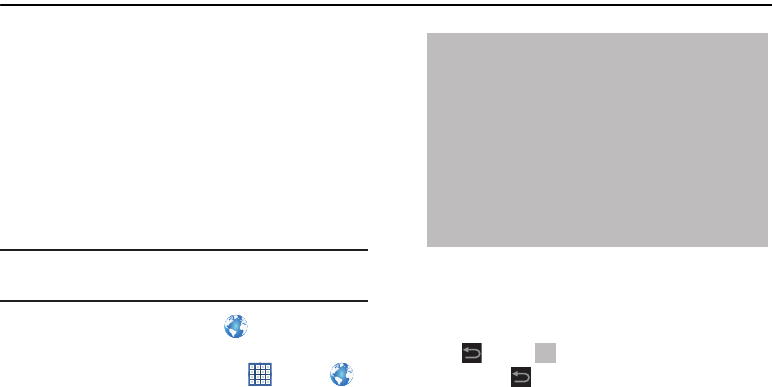
112
Section 7: Connections
This section describes the various connections your device
can make including accessing the Internet with your
Browser, Wi-Fi, Bluetooth, and Connecting to your PC.
Internet
The
Internet
browser is your access to the mobile web. This
section explains how to navigate Internet and introduces you
to the basic features.
Accessing the Web
Your device is equipped with a full HTML Browser that allows
you to access the Internet.
Tip:
By default, an
Internet
shortcut appears on the Home
screen.
䡲
From the Home screen, touch
Internet
.
– or –
From a Home screen panel, touch
Apps
➔
Internet
.
The Most visited screen displays.
Navigating the Internet
The following options are available for Internet navigation.
Command Keys
•
Touch
Back
or to return to the previous page.
•
Touch and hold
Back
to display browser History. For more
information, refer to
“Accessing Bookmarks and History”
on
page 115.
DRAFT
FOR INTERNAL USE ONLY

Connections 113
•
Touch
Forward
to go forward to a recent page.
•
Touch
Refresh
to reload the current page.
Touching and Dragging
•
Touch and drag your finger on the screen to navigate pages and
to reposition pages within the screen.
Entering Text in a Field
•
While browsing, touch a text field to display the virtual QWERTY
keyboard to enter text.
Zoom
•
Tap the screen twice to zoom in or out.
• Use two fingers, such as your index finger
and thumb, to zoom out by making an
inward pinch motion on the screen. To zoom
in, make an outward motion by sweeping your fingers out.
Tip:
For convenient browsing, you can rotate the device to
landscape mode.
Selecting Items On a Page
While browsing, use gestures and menus to navigate:
•
Touch an item to select it.
•
Touch a hyperlink to follow the link.
•
Touch and hold on a hyperlink for these options:
–
Open
: Open the linked page.
–
Open in new tab
: Open a new window to display the linked
page.
–
Save link
: Save the linked page to Download history.
–
Copy link URL
: Save the link’s URL to the clipboard.
–
Select text
: Copy the link text to the clipboard.
•
Touch and hold an image for the additional options:
–
Save image
: Download an image. View downloaded images in
Gallery.
–
Copy image
: Copy an image to the clipboard.
–
View image
: View the image source.
–
Set as wallpaper
: Use the image as your home screen
wallpaper.
DRAFT
FOR INTERNAL USE ONLY
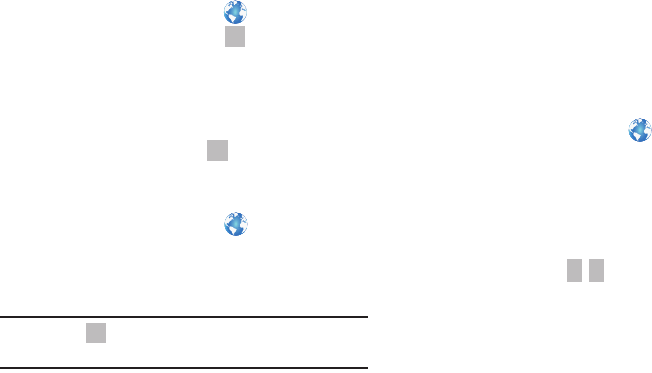
114
Using Browser Windows
You can have multiple windows open at one time and easily
switch between windows.
1. From the Home screen, touch
Internet
.
2. To open a new window, touch at the top of the
screen.
3. To switch to another open window, touch its tab at the
top of the screen.
4. To delete an open window, touch the tab at the top of
the screen, and then touch .
Entering a URL
Access a website quickly by entering the URL.
1. From the Home screen, touch
Internet
.
2. Touch the
URL
field at the top of the screen, then enter
the URL using the virtual QWERTY keyboard.
As you enter characters, potential matches display.
Note:
Use the
Delete
key to clear the URL field, if
necessary.
3. Touch a match to complete the URL.
– or –
Continue entering characters and touch the
Go
key to
load the page.
Copying Fields or Text
Copy information from a webpage to the clipboard for
pasting, searching, or sharing.
Selecting, Copying, and Pasting Text
1. From the Home screen, touch
Internet
.
2. Browse to a webpage.
3. On the webpage, touch and hold on the text until you
see the text you want highlighted, then stop touching
the screen.
The text is highlighted.
4. Touch and drag the tabs to the left or right to
select more or less text.
5. Touch
Copy
at the top of the screen to copy the
selected text or touch
Done
to stop.
6. To paste the copied text, navigate to the desired field
(or to another application), then touch and hold in a text
field and touch
Paste
in the pop-up.
DRAFT
FOR INTERNAL USE ONLY
